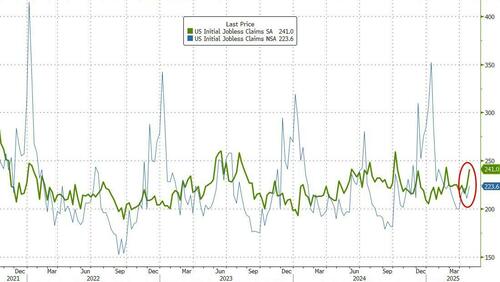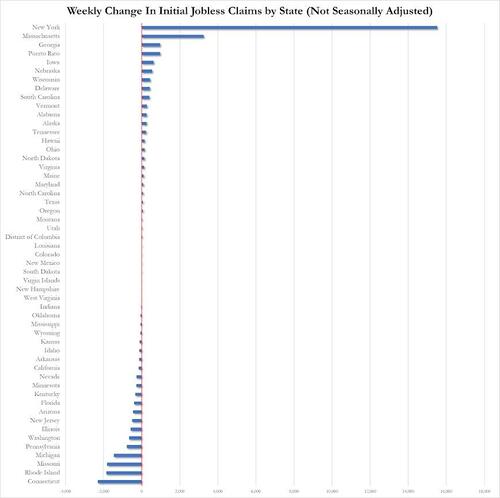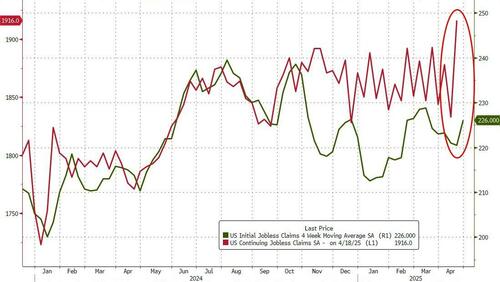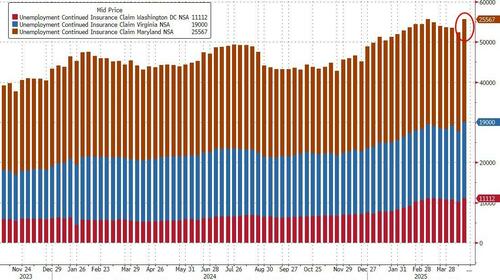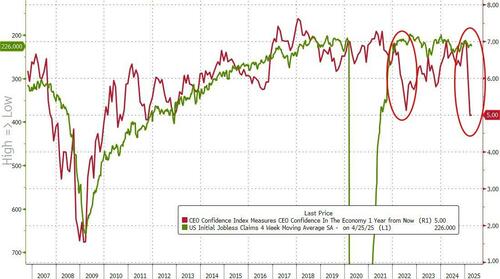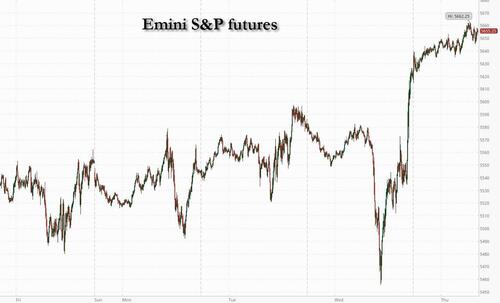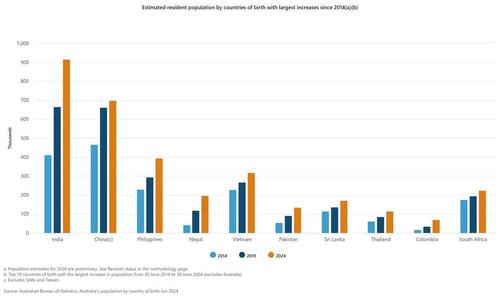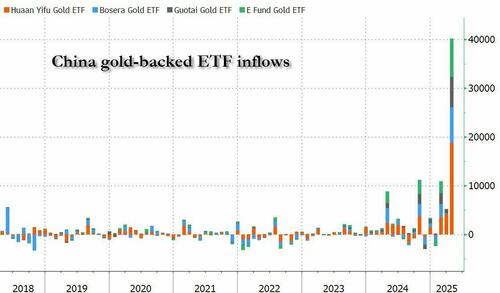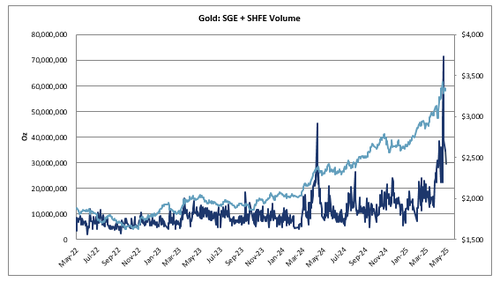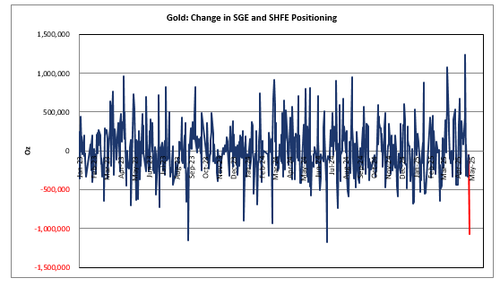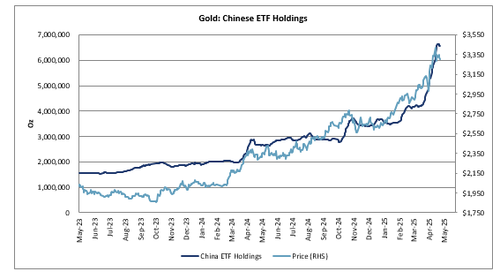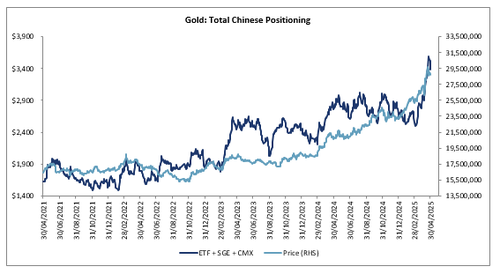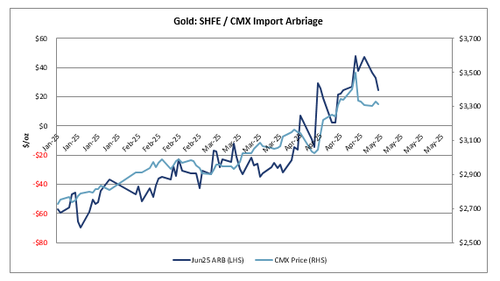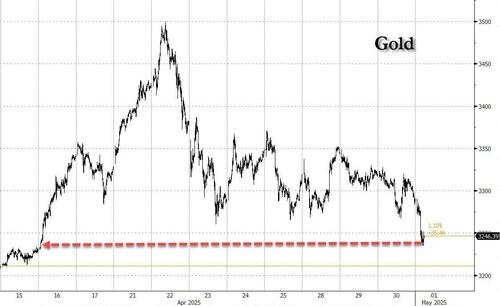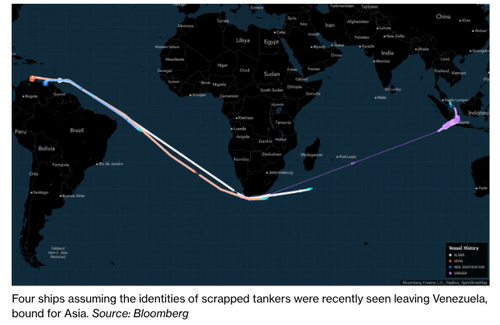Certainly, it is difficult to make the demands of the Gospel understandable to secularized people. But this pastoral difficulty must not lead to compromises with the truth.
Distinction Matter - Subscribed Feeds
-
Site: Mises InstituteIf we accept the Peronist views of the late pontiff, we obviously cannot support the marketplace. But fortunately, there is a better option available to us.
-
Site: Saint Louis Catholic
Waiting
Seeing
Praying
Let’s pray harder
St. Joseph Opificis, Terror of Demons and Protector of Holy Church, pray for us!
-
Site: PaulCraigRoberts.org
After 100 Days Where Are We?
Paul Craig Roberts
About a month or so ago on March 23 I posted on this website my memoir of my time in the Reagan administration which had just been published in The Independent Review, a readable quarterly. I expected to hear more than I did in response to my memoir, because I spelled out how difficult it is for a presidential appointee to actually support the policy of the President. https://www.paulcraigroberts.org/2025/03/23/my-time-in-the-reagan-administration/
Then it occurred to me that the Reagan administration was a long time ago, 1981-1988. President Reagan’s term ended 37 years ago. So an American 50 years old today was 13 years old when Reagan’s second term ended. He was 5 years old when Reagan was elected president. A 50 year old American never experienced the Reagan administration. A 60 year old American was only 15 when Reagan took office. The vast majority of Americans alive today know nothing of the Reagan administration except the accounts of the presstitute media and historians grinding ideological axes. Yet, somehow, Americans say they miss Reagan, the last American president.
With Trump’s first 100 days behind us, MAGA Americans are touting his successes and the Democrats are multiplying his “failures.”
Let me tell you about a real successful president–Ronald Reagan–Perhaps the only successful president in the 20th century. Reagan had two major successes. I know because I was part of them. Reagan cured stagflation–the simultaneous rise of inflation and unemployment– with his supply-side policy, and he ended the Cold War with the Soviet Union. Tell me, what American president has had such extraordinary successes?
Reagan’s success was covered up with media hype about “the teflon President,” with the neoconservatives’s Iran/Contra scandal, with “the Reagan deficits” that belong to David Stockman and Paul Volcker.
American historians, academics who guarantee their careers by justifying the various atrocities their governments commit, rank the top five US presidents as Abraham Lincoln, George Washington, Franklin D. Roosevelt, Theodore Roosevelt, and Dwight D. Eisenhower in that order. https://www.c-span.org/presidentsurvey2021/?page=overall
Lincoln destroyed the Constitutional framework based on states’ rights as designed by the Founding Fathers. Lincoln introduced war against civilians as an essential part of war against the opposing army. Today the International Criminal Court would recognize Lincoln as a war criminal and issue arrest warrants.
Thomas Jefferson, who wrote the Declaration of Independence, ranks 7 after Harry S. Truman, who nuked two Japanese civilian cities while the Japanese government was pleading with Washington for peace.
John F. Kennedy comes in 8th, Ronald Reagan 9th, Barack Obama, who bombed 7 countries comes in 10th, and President Lyndon Johnson–“LBJ, LBJ, How Many Kids Did You Kill Today”–comes in 11th.
What we see here are the liberals, not willing to dethrone the first American president, or a Founding Father who wrote the Declaration of Independence, or John F. Kennedy a martyr, or Reagan whose popularity remains high, shielding themselves from partisanship by including Jefferson, Kennedy, and Reagan in the second tier of successful presidents..
Lincoln destroyed the US Constitution which is based on states rights. He conducted a war of war crimes against an agricultural society that could not afford to pay the Morrill Tariff in order to industrialize the North at the expense of the South. No sooner than the South was destroyed, the Union launched a war of extermination against the native American Plains Indians, the same Union Generals–Sherman and Sheridan–the same Union soldiers that raped and pillaged the South repeated the application to the remaining Native Americans. As Lincoln’s reward for genocide, he is voted by American historians as the best ever–the Number One-of all American presidents.
Franklin D. Roosevelt gets the third ranking, because he replaced the power of Congress with the power of regulatory agencies.
Theodore Roosevelt is bestowed the 4th ranking because he established the American policy of empire and hegemony.
One assumes Eisenhower’s fifth rank is because he is alleged to have won World War II for the US.
Truman is 6th because he nuked Japan, thus putting the Soviet Union on notice.
If you look at these achievements, Washington and Jefferson, aside, Ronald Reagan at number 9 on the list is the only one who rescued America from an economic catastrophe and a Cold War that could have turned hot.
Liberals and what passes for a left-wing say that Reagan was just another fake, another warmonger committed to the Soviet Union’s destruction. But a president who was a fake would never, ever, put me in charge of his economic policy, nor would he appoint me to a secret presidential committee to verity or disprove the CIA’s argument against ending the Cold War. I am the last person on earth that a fake President wants to hand a Presidential Appointment or a decision on a critical foreign policy issue.
So, now that we have all of the congratulatory and denunciatory accounts of Trump’s 100 Days, what do they mean?
Trump did a good thing in service to justice when he pardoned and released from prison the framed-up-by-the-Biden-anti-American-regime American citizens who used their Constitutional rights to protest a stolen presidential election. But the corrupt persons who framed up innocent Americans have not been arrested and indicted, as they should be. Why is Trump focused on Ukraine rather than on those who framed innocent Americans as “insurrectionists”?
The Democrats have shown that they will strongly resist Trump’s rollback of the legal privileges Democrats created for DEI-designated-persons and for immigrant-invaders. Democrat district court judges, the lowest of the low, have claimed the right to decide the power of the President of the United States to govern. Trump’s reply is that he abides by judicial rulings. Trump is relying on the Supreme Court to overturn the district courts, but if that doesn’t happen, will Trump fight?
Trump himself makes deals with Zelensky and claims they are deals Putin must accept. This is nonsensical. The conflict is between the US and Russia. The deal has to be made between Trump and Putin.
The real problem is the neoconservative doctrine of American hegemony As long as American foreign policy is based on Paul Wolfwitz’s doctrine, there can be no peace.
Trump has not repudiated the doctrine of American hegemony. Until he does, how can Putin trust him?
-
Site: PaulCraigRoberts.org
Is the Purpose of the Peace Negotiations to Sequence the West’s Wars with Russia and China?
Paul Craig Roberts
President Putin’s National Security Advisor Nikolay Patrushev recently stated that, Ukraine negotiations notwithstanding, the West is “deploying their military machine against Russia and becoming delirious with nuclear apocalypse scenarios.”
”For a second consecutive year, NATO is conducting exercises at our borders at a scale unseen in decades,” Patrushev said. “They are training for conducting a broad offensive from Vilnius to Odessa, seizing [the Russian exclave] Kaliningrad Region, imposing a naval blockade in the Baltic and the Black Seas, and executing preventive strikes on the staging locations of Russian nuclear deterrence forces.”
https://www.rt.com/russia/616473-patrushev-nuclear-conflict-west/
Reports are emerging from Russia that Putin wants a Ukrainian settlement so that Russia can prepare for a war that the West is bringing to Russia in three years when the British, French, Poles, and Germans are prepared. Putin wants to disengage from Ukraine in order to prepare for the real thing.
If Israel succeeds in getting Trump to attack Iran, the timetable will be thrown off.
Unless President Trump and the US Congress renounce US hegemony and declare America’s independence from Israel, no peace is possible.
I discuss with Nima on Dialogue Works whether the “peace negotiations” are a technique to move Russia aside while Washington takes on China: https://www.youtube.com/live/9DqDUqoVZI0
-
Site: PaulCraigRoberts.org
Weaponizing Anti-Semitism
The Jew cries out in pain as he strikes you.
Polish proverbBritish Labour Leader Jeremy Corbyn was removed by anti-semitism accusations.
Jewish journalist Simon Heffer announced on radio that Corbyn “wanted to re-open Auschwitz.”
British PM Starmer’s “first act as Labour leader was not to address the conditions of the working class, but to reassure “the Israel Lobby that they were back in the driver’s seat.”
Starmer invited an Israeli spy to head British surveillance of citizens on social media. The anti-semitism cases brought against British citizens are now prepared by an Israeli.
Free speech originated in Britain, and it has died there. British citizens can no longer make any critical remark that pertains to Jews, Muslims, Arabs, blacks, or Asians unless they are Chinese, Japanese, or North Koreans.
President Trump is now applying the same standard to American universities and their students. Leaders such as Starmer and Trump who do not respect free speech do not respect democracy.
https://www.unz.com/article/trial-by-jewry-asa-winstanley-on-weaponizing-anti-semitism/
-
Site: Catholic Herald
Every so often there comes a moment in history when the world’s entire attention is focused on a particular event or person – the death of a pope is one such example. When Pope Francis appeared to give Urbi et Orbi on Easter morning, and to be driven around St Peter’s Square for what would be the final time, he looked so unwell that it seemed obvious that he would not live much longer. With impeccable timing, which could hardly have been more dramatic, he died that night; the last act of this Servant of the Servants of God was to impart his apostolic benediction to Rome and the world beyond its gates.
The response to his death has been remarkable; an international outpouring of tangible grief accompanied by a generally sincere yearning for information. Very quickly requests arrived for interviews from local and international broadcasters – from the UK, Australia and the United States. I did my best to accept as many as possible, and found the experience extremely varied. As we have covered online and in these pages, Pope Francis’s character was a fascinating combination of openness and inscrutability – and occasionally of contradiction, too. For many of my interlocutors this seemed to come as something of a surprise.
Meanwhile, with my historian’s hat on, what was particularly fascinating was the response of the British establishment. The King – the Supreme Governor of the Church of England, and successor of Henry VIII – released a heartfelt tribute and conducted official engagements in mourning dress. Flags were flown at half-mast on government buildings, as indeed they also were in the United States. Meanwhile, the Archbishop of York – both the papacy and the See of Canterbury are simultaneously vacant for the first time since 1691 – publicly prayed for the repose of Pope Francis’s soul. What was that about a Reformation?
The reaction online, in an arena that Pope Francis inhabited so effectively, was immediate; so too was the speculation, sometimes frenzied and in many cases perhaps rather too soon for good taste, about who his successor might be.
The Guardian reported that online viewing of Edward Berger’s recent film Conclave, which won best picture at the Baftas and was nominated for eight Oscars, soared by 283 per cent in the days following his death.
As this month’s May edition of the Catholic Herald magazine went to press, the focus in Rome was on the lying-in-state and the papal funeral; very soon it will shift to the conclave, and by the June issue we will almost certainly know who will come next. We will know, too, what his papacy will be like from the moment his name is announced by the senior cardinal deacon: Francis II? Benedict XVII? John Paul III? Pius XIII has surely been ruled out by Jude Law in The Young Pope.
The betting shops wasted no time in publishing their odds, either. Placing a wager on the outcome of a conclave used to be an excommunicable offence, but names have risen and fallen in the rankings like horses at the Derby – some of the touted papabili found themselves mobbed like celebrities in the streets of Rome. Will the next pope come from Asia or Africa? Will the electors think that after five decades, it is time for an Italian to be Bishop of Rome? Will he be well known, like some of the prefects of dicasteries, or from the peripheries of the Church, which Pope Francis loved so well? At the time of writing, God alone knows.
What is certain, however, is that he will have his work cut out. Among other things, whoever appears on the balcony of St Peter’s Basilica in due course will have to contend with the near-collapse of the Church in her traditional heartlands, bring peace once more in the liturgy wars, continue to work on reforming the Vatican’s finances, and move heaven and earth to tackle decisively and effectively the suppurating scandal of abuse. And all this he must do as a febrile world teeters on the edge of further violence and instability – as if personal responsibility for 1.4 billion souls were not already burden enough.
Photo: Pope Francis prays in front of the statue of the Immaculate Conceptionon at Spanish Steps, Rome, Italy, 8 December 2013. Following a tradition laid out by his predecessors, Pope Francis celebrated the Feast of the Immaculate Conception by travelling to Spanish Steps where he venerated the statue named for the Marian Feast. The statue of the Immaculate Conception was consecrated on 8 December 1857, several years after the dogma which states that Mary was conceived without the stain of original sin was adopted by the Church. (Photo by Franco Origlia/Getty Images.)
This article appears in the May 2025 edition of the Catholic Herald. To subscribe to our thought-provoking magazine and have independent, high-calibre and counter-cultural Catholic journalism delivered to your door anywhere in the world click HERE.

The post Taking personal responsibility for 1.4 billion souls: the spectacle gripping the world first appeared on Catholic Herald.
The post Taking personal responsibility for 1.4 billion souls: the spectacle gripping the world appeared first on Catholic Herald.
-
Site: LifeNews
My husband and I have been involved in starting crisis pregnancy centers in several counties in North Carolina. Ed is a pastor and we felt the call to come to Fayetteville, North Carolina. We started the Agape Pregnancy Support Services in a house on Cedar Creek Road. After we had been there for two years something happened to change our location.
Fayetteville was the home of an abortion clinic that had been there for twenty-seven years. Many thousands of babies died in that clinic. Many Christians in the community would drive by the clinic and pray that the doors would close. God did answer their prayers and the doors of the clinic closed. The building was abandoned and the homeless would sneak into the building at night. It was a horrible place.
One night I was restless so I decided to read. My daughter had given me a book called “The Dream Giver” by Dr. Bruce Wilkerson. In the book the author talks about getting out of our comfort zone and walking in faith. The next morning God asked me to get out of my comfort zone and go purchase the old abortion clinic. I told God I didn’t want that building. I asked if He didn’t have a new building we could have.
I said, “Lord this is a place of death.”
God said, “I have a special plan for this place. I am going to take back what Satan has used for evil and redeem it. I will bring life from this place and it will bring glory and honor to me.”
I called the number on the building and asked the price. The price was $120,000.
I reminded God that I was a kindergarten teacher and I only had a few dollars until payday. I knew that God would have to provide the money. God promised if we walked by faith, He would provide the money.
HELP LIFENEWS SAVE BABIES FROM ABORTION! Please help LifeNews.com with a donation!
Ed and I went to the old building; it was a horrible mess.
It was trashed with drug needles; beer, wine, and liquor bottles; rags, condoms, and human feces where the homeless had stayed. The windows were boarded up and it was very dark. We walked into the building carrying flashlights. You could feel the demonic powers in the place. We walked through the building shining the light into each room. each room had a plan and God revealed what it would be used for. At the back of the building, there were two procedure rooms with Formica walls and drainage in the floor. One procedure room had equipment left with blood on it and blood on the Formica walls. I stood at the door feeling as if I was going to throw up.
God said, “You have to go into the room. You must feel what I feel.”
As I walked into the room, I could feel the pain and sorrow. I heard the babies crying because they didn’t get to live the life God had planned for them. They were also crying because they missed their moms. I heard the moms crying because they had killed their children. The third voice I heard in the room was my Lord and Savior weeping for all that was lost. My answer was “Yes”. He reminded me that it would be hard and the cost would be great. The answer was still “Yes!”
One month later my mom died. God revealed that these two procedure rooms would be an ultrasound room and the other a chapel. The chapel would be a place for women to come and find forgiveness for their abortions. It would be a place to come out of the darkness into the light of Jesus. A man in our church did purchase the building and we make payments each month. (Today, the mortgage is paid off.) We started working on the building. We anointed every room in the building. We prayed, painted, and cleaned all for the glory of Jesus.
The first room to get the boards off the windows was the chapel. As the boards came off, the light of Jesus flooded the chapel and the building. You could feel that Jesus had reclaimed what the enemy had for a season.
I told my husband, “Look Honey, there goes the Devil with his packed bags and he will not be coming back to this place.”
The Agape Pregnancy Support Services is on the tough side of town. We have prostitutes, drug addicts, pimps, and the homeless walking the street in front of the building. I had a dear Christian lady ask me if I knew what side of town the center was in. I smiled and said, “Yes, I do. I am exactly where Jesus would be.” We know that God has placed us in this place. We are able to minister to the people of the streets and our clients. I see God taking people from death to life eternally just as He did with this old abortion clinic. God is the author of Life both physical and eternal.
LifeNews Note: Helen McLeod Rogers is the director of Agape Pregnancy Support Services in Fayetteville, North Carolina.

The post This Was an Abortion Center, Until a Christian Family Bought It and Dedicated It to God appeared first on LifeNews.com.
-
Site: Zero HedgeJobless Claims Jumped Last Week As 'DOGE Actions' Spark Biggest YTD Layoffs Since 2020Tyler Durden Thu, 05/01/2025 - 08:39
So far this year, employers have announced 602,493, the highest year-to-date total since 2020 when 1,017,812 job cuts were recorded, according to the latest data from global outplacement and executive coaching firm Challenger, Gray & Christmas.
It is up 87% from the 322,043 cuts announced during the same period in 2024.
The Government leads all sectors in job cuts this year with 282,227; 281,452 of which are attributed to DOGE-related cost-cutting.
This is up 680% from the 36,195 job cuts announced in this sector through April 2024. In April, the number of job cuts announced in this industry was 2,782. DOGE actions were attributed to 2,731, while the rest were attributed to “Economic Conditions” and “Cost-Cutting.”
-
“DOGE Actions” lead all job cut reasons in 2025 with 283,172; 2,919 of which occurred in April. Another 6,945 cuts were attributed to “DOGE Downstream Impact” through April, primarily at Non-Profits and Education organizations. These reasons combined (290,117) make up 48% of all job cuts announced so far in 2025.
-
Market/Economic Conditions were cited for 95,348 job cuts, as economic uncertainty, consumer spending, and trade difficulties impact US-companies.
Tariffs were cited for 1,413 cuts so far this year, with 1,350 occurring in April. Restructuring accounted for 67,627, and 60,551 were due to store, unit, or location “Closing.”
This weak labor market data comes on the heels of yesterday's dismal ADP Employment report.
This morning we see initial jobless claims jump notably too - to 241k (higher than the 223k expected). While not out of recent norms, this is a sizable jump...
Source: Bloomberg
Interestingly, New York dominated the surge in initial claims...
Continuing jobless claims also surged last week, back above 1.9 million Americans - its highest since Nov 2021...
Continuing claims for the 'Deep TriState' rose significantly last week...
Source: Bloomberg
As SouthBay Research highlights, the ~80K jump in Continuing Claims is relatively broad, with core drivers being New York (+14K), California (+9K), Connecticut (+5K), New Jersey (+4K), Texas (+6K).
This most definitely points to economic headwinds translating into lower payrolls.
While the 1-week 80K jump stems mainly from the seasonal adjustments (Non Seasonally Adjusted Continuing Claims rose 26K), it clearly points to lower hiring underway in the first 2-weeks of April. Precisely when the Nonfarm Payroll Survey was done.
Still, in context, it seems CEOs are all willing to whine about the economy but their actions speak louder than their words...
“Though the Government cuts are front and center, we saw job cuts across sectors last month. Generally, companies are citing the economy and new technology. Employers are slow to hire and limiting hiring plans as they wait and see what will happen with trade, supply chain, and consumer spending,” Andrew Challenger, Senior Vice President and workplace expert for Challenger, Gray & Christmas.
...and none of this is a good sign for tomorrow's all-important payrolls print.
-
-
Site: Catholic Herald
In 1955, Pope Pius XII instituted the Feast of St Joseph the Worker as an intentional answer to the Communist inflected “International Workers’ Day”. His purpose was to reclaim the nature and purpose of work, rooted in a proper understanding of God, man and society. Pius affirmed the dignity of work without the pernicious baggage of atheistic materialism. While the 1 May feast celebrates St Joseph, it is also an opportunity to reflect upon work as a participation in the creative nature of God. God is the first “ working man”, and His work gives us a foundation for understanding the role of labour in our own lives.
As Genesis 2:2 explains, creative work is “natural” to God. And because the human person is made in the image and likeness of God, we can deduce that one aspect of that image and likeness is that man is also ordered in his essential nature to work. We learn what the image of God is by observing what God does. God works, and we are made in His image; therefore, we are made for work as a natural aspect of our being. And because God Himself is the first worker, we can see the inherent dignity in work. This dignity is expressed in the very ability of man to work, and thus to contribute to his own personal development.
But many people who read this will say to themselves, “My work is not very dignified.” It is true that for many people work is a tedious, arduous grind rather than a dignified activity. This does not refute the natural, inherent dignity of work, however. Rather, the drudgery of work is yet another result of the fall of the human person, which is so pervasive that it involves all aspects of our lives. The essence of the fall is the rejection of the natural end of the human person as ordered toward God. Indeed it is the rejection of God as man’s final end. But if this most fundamental relationship is now disordered, it “naturally” follows that all other aspects of human life are also disordered. This includes our relationship to work or even work itself.
Another name for this disorder is “alienation”. When we alienate ourselves from God, we are disordered from our true end and purpose. Thus, we are alienated and disordered from every other good that is natural to the human person, including work. In this context, the word “alienation” is particularly appropriate, as it not only describes the state of man in The Fall, but also one of the fundamental challenges to a theology of work in the modern context.
A theology of work must begin with the fundamental problem of alienation and how it can be resolved. Whether from his employer, his fellow employees, or the labour of his hand or intellect, alienation is at the heart of the Marxist criticism of the industrialised economy. And, indeed, these are serious problems to which Marx was correct to call our attention. Unfortunately, he was wrong about the causes and remedies for this alienation.
The specific expression of our alienation to work after The Fall is illustrated in Genesis 3, when God announces the effect of the new state of disorder. “Cursed be the ground because of you,” He declares. “In toil shall you eat its yield all the days of your life. Thorns and thistles shall it bring forth to you…By the sweat of your face shall you get bread to eat” (Genesis 3:17-19a). Similarly, after Cain slays Abel in Genesis 4, God tells Cain: “If you till the soil, it shall no longer give you its produce” (Genesis 4:12). Thus Cain was alienated from his proper and natural end of cultivating the earth and forced to wander as an alien in the land.
Alienation from work is a common experience of many people (even for those who have not killed a sibling). But, like all aspects of human life, God has redeemed work in the life, death and resurrection of Christ. Christ came to reorient us toward the Father and, thus, to reorder and restore our lives to their proper ends and purposes, both natural in this life and supernatural in the life to come.
One aspect of the former is that God has given us a renewed understanding of the nature and purpose of work, as well as the theological resources to articulate a revival of the dignity of all work. In the context of our redemption in Christ, even work that does not seem to be very dignified can be ordered toward its proper ends and purposes, thus retrieving and reviving its dignity.
This brings us back to the Feast of St Joseph the Worker. In St Joseph, we have a model of quiet, dignified work that serves the higher purposes of God’s redemptive activity in the world. God commissioned Joseph to work; Joseph’s work contributes to God’s own.
Photo: (Photo by Eva Marie UZCATEGUI / AFP)
This is an edited extract from Dr Craycraft’s Citizens Yet Strangers: Living Authentically Catholic in a Divided America ( OSV, 2024).
This article appears in the May 2025 edition of the Catholic Herald. To subscribe to our thought-provoking magazine and have independent, high-calibre and counter-cultural Catholic journalism delivered to your door anywhere in the world click HERE.

The post Appreciating the dignity and purpose of work this Feast Day of St Joseph the Worker first appeared on Catholic Herald.
The post Appreciating the dignity and purpose of work this Feast Day of St Joseph the Worker appeared first on Catholic Herald.
-
Site: Zero HedgeUS Futures Surge On Blowout Tech Earnings, Erasing April's LossesTyler Durden Thu, 05/01/2025 - 08:26
US equity futures are sharply higher, erasing all of April's losses on blowout earnings from MSFT and META, and relief over signs the Trump administration is stepping back from its harshest tariff threats. As of 8:00am ET, S&P futures rose 1.2% to 5655, the highest level since before Trump's Liberation Day announcement and pointing to an eighth consecutive session of gains for the cash index; Nasdaq futures gained 1.7%, as META and MSFT added +6.3% and +7.8%, respectively; most Mag 7 names, NVDA (3.7%) and semis are higher given META’s CapEx increase and MSFT’s reiteration on CapEx guidance. The dollar is higher after the BOJ finally flipped dovish and slashed its growth target pushing USDJPY to 144.5 this morning. It's light on overnight news as most of Europe is closed today ex-UK along with China; US/Ukraine signed an agreement over the country’s natural resources, UK Manf PMI printed better but remained in contraction, and Trump reiterated that there is a “very good chance” of a deal with China on NewsNation last night. Commodities are mostly lower: WTI -1.2%; Gold -1.7%. The US economic calendar includes weekly jobless claims (8:30am), April manufacturing PMI (9:45am), ISM manufacturing and March construction spending (10am). Fed’s external communications blackout ahead of the May 7 FOMC meeting. Apple and Amazon results are due after the market close.
In premarket trading, the Magnificent Seven are mostly higher: Microsoft (MSFT) gains 8% after the company reported stronger-than-expected quarterly sales and profit growth. Meta (META) jumps 6% after the company’s advertising sales quelled Wall Street concerns about the impact of the Trump administration’s trade war. Apple was the only tech giant in the red, falling 1.4% after a federal judge said in a ruling that it violated a court order requiring it to open up the App Store to third-party payment options (other Mag7s are up Nvidia +4.6%, Amazon +3.7%, Alphabet +1%, Tesla +0.7%).
McDonald’s Corp. (MCD) declines 1.4% as sales fell in the first quarter, reflecting a deterioration in consumer sentiment that’s making it harder for restaurants to lure in diners. Eli Lilly & Co. (LLY) drops 5% after the company cut its earnings outlook. Here are some other notable premarket movers:- Align Technology rises 10% after the Invisalign company reported quarterly shipments that beat the average analyst estimate.
- Confluent Inc. falls 10% after the provider of a streaming platform gave an outlook for second-quarter subscription revenue that fell shy of expectations. First quarter results showed a slowdown in additions of customers with $100,000 in annual recurring revenue.
- CVS Health rises 8% after the company boosted its adjusted earnings per-share-guidance for the full year and reported better-than-expected results for the first quarter
- E2open shares are up 34% after WiseTech Global, in response to media reports about its being in discussions to acquire E2open, said it was participating in a strategic review process.
- KKR & Co. rises 2% after the investment firm reported assets under management that beat the average analyst estimate. Fee-related earnings also came in above analysts’ expectations.
- Qualcomm falls 5% as the biggest maker of chips that run smartphones gave a tepid revenue prediction for the current quarter, underscoring concerns that tariffs will hurt demand for its products.
- Robinhood gains 4% after the trading platform’s earnings largely beat expectations, with analysts highlighting positive trends in April amid market volatility and a boost from a lower tax rate.
- Shake Shack falls 3% after posting first-quarter results.
- Wayfair gains 5% after posting adjusted earnings per share for the first quarter that beat the average analyst estimate.
Tech giants added to investor optimism that deals between the US and its partners would limit the damage from Trump’s trade war. Wall Street ended a tumultuous month on a day in which the S&P 500 erased an intraday drop of more than 2% to close 0.2% higher. Traders sought reassurance in bets on Federal Reserve easing after the US economy contracted for the first time since 2022.
“So far we’re seeing big tech companies deliver on earnings, which is reassuring, and it’s this reassurance which is supporting equity market futures,” said Georgios Leontaris, chief investment officer for EMEA at HSBC Global Private Banking. “The other element of the story beyond earnings is obviously the ongoing debate as to whether we’ve seen peak tariff noise or not.”
Apple results are due after the market close. Analysts will be listening closely for any further detail on how the company, whose supply chain is reliant on China, Vietnam, and India, views the impact of tariffs
The White House said it was nearing an announcement of a first tranche of trade deals with partners that would reduce planned tariffs. Sentiment was also helped by a report that the US has been proactively reaching out to China through various channels. At the same time, Trump said he would not rush deals to appease nervous investors.
The US and Ukraine reached a deal over access to the country’s natural resources, offering a measure of assurance to officials in Kyiv who had feared Trump would pull back his support in peace talks with Russia.
Elsewhere, most markets in Europe and many in Asia are shut for holidays. The UK’s FTSE 100 index was steady, following 13 days of gains, the longest winning streak since 2017. Gains in material and industrial names are offset by losses in energy and health care.
In FX, the Bloomberg Dollar Spot Index rises 0.3%. the yen is the weakest of the G-10 currencies, falling 0.9% against the greenback after the Bank of Japan pushed back the timing for when it expects to reach its inflation target and slashed its growth forecasts. The pound and euro are little changed.
In rates, treasuries climb, pushing US 10-year yields down 2 bp to 4.14%. Treasury spreads remain within a basis point of Wednesday’s close, as gains remain broad-based across the curve. Gilts are steady, with UK 10-year borrowing costs flat at 4.44%. Treasury futures edge higher into the early US session, on the day’s highs with yields lower by 1bp to 2bp across the curve. US session focus includes weekly jobless claims along with both ISM and PMI manufacturing reports.
In commodities, oil prices decline, with WTI falling 2.3% to below $57 a barrel; the drop followed the biggest monthly drop since 2021, as signs that the Saudi-led OPEC+ alliance may be entering a prolonged period of higher output added to concerns the trade war will hurt demand. Spot gold is down $65 at $3,223/oz, falling for a third day on signs of potential trade-talk progress between the US and several other nations, quelling demand for havens even as signs of slowdowns have emerged in the largest economies. Bitcoin rises 1% and above $95,000.
Looking at today's calendar, we get the April Challenger job cuts (7:30am), weekly jobless claims (8:30am), April manufacturing PMI (9:45am), ISM manufacturing and March construction spending (10am). Fed’s external communications blackout ahead of the May 7 FOMC meeting
Market Snapshot
- S&P 500 mini +1.2%
- Nasdaq 100 mini +1.6%
- Russell 2000 mini +0.3%
- Stoxx Europe 600 little changed
- DAX +0.3%
- CAC 40 +0.5%
- 10-year Treasury yield -2 basis points at 4.15%
- VIX -0.9 points at 23.85
- Bloomberg Dollar Index +0.2% at 1226.38
- euro little changed at $1.1324
- WTI crude -2% at $57.02/barrel
Top Overnight news
- The US and Ukraine signed an agreement over access to the country’s natural resources. The deal will see the US will get first claim on profits transferred into a jointly managed investment fund that’s intended in part to reimburse the US for future military assistance. BBG
- House Republicans are seriously considering proposals to further limit tax deductions that companies can take for their highest-paid workers’ compensation, expanding restrictions that now apply only to a handful of current or former executives making more than $1 million, according to people familiar with the discussions. WSJ
- US President Trump said we are going to have 'Made in the USA' like never before and he stated give us a little time to get moving regarding the economy. Furthermore, Trump said interest rates should go down and reiterated that "he (Powell) should reduce interest rates, I understand them better than him", as well as noted it would be nice for people wanting to buy homes and things.
- There was some chatter that the House Ways and Means Committee is going to mark up their tax package on May 8th: Punchbowl.
- Elon Musk said he’s considering sending DOGE to the Fed, citing a costly renovation of its headquarters as an example of potential government waste. BBG
- The yen dropped as much as 1.2% after the BOJ pushed back the timing for when it expects to reach its inflation target and Governor Kazuo Ueda spoke of uncertainties due to tariffs. For now, policymakers kept rates at 0.5%. BBG
- China feels the white house is “too divided” on trade policy and will hold off on entering serious trade talks with the US while it waits to see which of Trump’s advisors will have his ear and how other countries respond to the 90 day pause on tariffs. SCMP
- Saudi Arabian officials are briefing allies and industry experts to say the kingdom is unwilling to prop up the oil market with further supply cuts and can handle a prolonged period of low prices, five sources with knowledge of the talks said. This possible shift in Saudi policy could suggest a move toward producing more and expanding its market share, a major change after five years spent balancing the market through deep output as a leader of the OPEC+ group of oil producers. RTRS
- The EU is planning to share a paper with the US next week that will set out a package of proposals to kick-start trade negotiations with the Trump administration. The paper will propose lowering trade and non-tariff barriers, boosting European investments in the US, cooperating on global challenges such as tackling China’s steel overcapacity and purchasing US goods like liquefied natural gas and technologies. BBG
- Janet Yellen has warned that Trump’s tariffs will have a “tremendously adverse” impact on the US economy as they “hobble” companies that rely on critical mineral supplies from China. She added: “I’m not yet ready to say that I’m forecasting a recession, but certainly the odds have gone way up. FT
- Microsoft beat estimates and showed strong growth in its key Azure cloud business, while Meta also topped estimates and raised its full-year capex forecast as it continues to invest in AI. With first-quarter earnings in full swing the scorecard so far has shown resilience amid Trump’s trade war. The next big test comes after the close, when Apple and Amazon report. BBG
Tariffs/Trade
- US President Trump reiterated there is a very good chance that they will make a deal with China and any deal has to be on their terms, while he added that they are negotiating with India, South Korea and Japan.
- US President Trump said after a certain amount of time, there will be a tariff wall for pharmaceutical companies.
- USTR Greer said it is a matter of weeks not months to have initial trade deals announced and he is meeting with Japan, Guyana and Saudi Arabia on Thursday and with the Philippines on Friday. Greer added he wouldn't say they are 'finish-line' close on an India trade deal but noted he has a standing call with India's Trade Minister and said they are working closely with the UK and moving quickly with countries ready to move forward on trade. Furthermore, Greer said Canadian PM Carney is a serious person and that President Trump wants a healthy relationship in North America, while he added there are no official talks with China yet and that harmful foreign trade practices, including those in China, need to be addressed.
- China is to hold off on entering serious trade discussions with the US while it waits to see which of US President Trump’s advisers will have his ear and how other countries will respond to the 90-day pause on tariffs, according to a source cited by SCMP
- US Senate narrowly rejected a bipartisan measure to block Trump tariffs with the vote count at 49-49.
Notable Earnings
- eBay Inc (EBAY): Shares +0.5% pre-market. Q1 profit beat estimates, and revenue also increased. The company announced that Peggy Alford was appointed CFO, replacing Steve Priest, as the company adjusts its leadership. It reported Q1 adj. EPS of 1.38 (exp. 1.34), Q1 revenue of USD 2.6bln (exp. 2.55bln). Q1 gross merchandise volume USD 18.75bln (exp. 18.52bln); International GMV USD 9.69bln (exp. 9.58bln); US GMV USD 9.07bln (exp. 8.92bln). In Q1, it had 134mln active buyers (exp. 134.17mln). Sees Q2 revenue between USD 2.59-2.66bln (exp. 2.60bln), and sees Q2 adj. EPS between 1.24-1.31 (exp. 1.29). (Newswires)
- Meta Platforms (META) - Shares +6.5% pre-market following a Q1 beat, while Q2 guidance was in line with expectations. Q1 revenue rose +16% to USD 42.31bln (exp. USD 41.4bln), with EPS of USD 6.43 (exp. USD 5.28); Q1 advertising sales were USD 41.39bln (exp. 40.55bln). Exec said daily users reached 3.43bln, while Threads has now has more than 350mln monthly active users. FY25 CapEx guidance was increased to USD 64–72bn for 2025 (prev. saw 60-65bln), and exec said that increased CapEx will bring data centre capacity online quicker. On AI, exec said its Meta AI app is focused on scaling and engagement this year, with business integration planned for next year; nearly 1bln monthly active users now use Meta AI across its apps. Exec also said that the EC's ruling may hit its EU business, where it will need to make modifications to ads model which could have significant impact to European business and revenue as early as Q3, while Asia ad spend fell amid regulatory uncertainty. Sees Q2 revenue between USD 42.5bln-45.5bln (exp. 44.41bln), lowered its FY25 total expenses view to USD 113bln-118bln (prev. saw 114-119bln). (Newswires)
- Microsoft (MSFT) - Shares +8.1% pre-market following a beat on Q3 sales and profits, driven by 20% cloud growth amid strong AI demand. The tech giant reported Q3 adj. EPS of 3.46 (exp. 3.21), Q3 revenue USD 70.1bln (exp. 68.41bln); Q3 CapEx USD 16.75bln (exp. 16.28bln). Azure and other cloud services revenue (Ex-FX) surged +33% (exp. +31%), with Azure growth attributable to AI 16pts (exp. 15.6ppts); the majority of Azure outperformance in Q3 was in its non-AI business. Q3 Cloud sales USD 42.4bln (exp. 42.22bln), Q3 Intelligent Cloud sales USD 26.8bln (exp. 25.99bln). Exec said H2 total CapEx view remains unchanged vs January guidance. Sees Q4 revenue between 73.3bln-73.4bln (exp. 72.0bln), Q4 CapEx expected to increase on a sequential basis, Q4 cloud gross margin expected to be 67% (down Y/Y), Q4 Intelligent Cloud revenue seen between USD 28.75bln-29.05bln (exp. 28.52bln), while Q4 Azure and other cloud services revenue growth is expected to be 34-35% in constant currency. Exec said that FY26 CapEx is expected to grow at a lower rate than FY25. (Newswires)
- Qualcomm (QCOM) - Shares +5.7% pre-market after it topped Q2 top- and bottom-line estimates, but Q3 guidance was light, and it sees a sales hit from US tariffs ahead. It reported Q2 adj. EPS 2.85 (exp. 2.80), Q2 revenue USD 10.84bln (exp. 10.60bln); Q2 QCT revenue USD 9.47bln (exp. 9.23bln), Q2 QTL revenue USD 1.32bln (exp. 1.35bln); Q2 Internet of Things revenue USD 1.58bln (exp. 1.45bln), Handsets revenue USD 6.93bln (exp. 6.84bln), Automotive revenue USD 959mln (exp. 909.8mln). Sees Q3 adj. EPS 2.60-2.80 (exp. 2.66), Q3 revenue between USD 9.9-10.7bln (exp. 10.33bln), sees Q3 QCT revenue between USD 8.7-9.3bln (exp. 8.98bln), and sees Q3 QTL revenue between 1.15-1.35bln (exp. 1.3bln). (Newswires)
A more detailed look at global markets courtesy of Newquawk
APAC stocks traded higher but with gains capped in severely thinned conditions owing to mass holiday closures across the region and in Europe for Labour Day. ASX 200 eked mild gains as the outperformance in tech, real estate and consumer staples was offset by losses across the commodity-related sectors, while trade data was mixed as Australian monthly exports returned to growth but imports contracted. Nikkei 225 advanced at the open after having reclaimed the 36,000 level and with further upside seen after the BoJ policy announcement where the central bank kept rates unchanged at 0.50% and provided some dovish rhetoric despite maintaining its rate hike signal.
Top Asian News
- BoJ maintained its short-term interest rate target at 0.5%, as expected, with the decision made by unanimous vote, while it said it will continue to raise the policy rate if the economy and prices move in line with its forecast and will conduct monetary policy appropriately from the perspective of sustainably and stably achieving the 2% inflation target. BoJ said Japan's economic growth is likely to moderate and underlying consumer inflation is likely to be at a level generally consistent with the 2% target in the second half of the projection period from fiscal 2025 through 2027, as well as noted that uncertainty surrounding Japan's economy and prices remains high with risks to the economic outlook and inflation outlook are skewed to the downside. Furthermore, it lowered its evaluation of the economic outlook and warned that a prolonged period of high uncertainties regarding trade and other policies could lead firms to focus more on cost-cutting, and as a result, moves to reflect price rises in wages could also weaken. In terms of the Outlook Report projections, the Real GDP median forecast for Fiscal 2025 was cut to 0.5% from 1.1% and the Fiscal 2026 estimate was cut to 0.7% from 1.0%, while the Core CPI median forecast for Fiscal 2025 was cut to 2.2% from 2.4% and the Fiscal 2026 forecast was cut to 1.7% from 2.0%.
- BoJ's Ueda Press Conference: Uncertainty from trade policy has heightened sharply. Expect to keep raising rates if the economy and prices move as projected. Timing to attain the underlying 2% inflation target will be delayed. Price goal timing delay doesn't mean delay in hikes; timing of trend inflation does not necessarily correlate with the timing of a hike.
Due to Labour Day across Europe, cash and derivatives markets are closed across Euronext services and those run by other European exchanges such as Deutsche Boerse, SIX and Nasdaq (Scandinavia closed ex-Copenhagen). The UK’s FTSE 100 is one of the few indices in Europe which is open today; currently flat.
Top European news
- EU is to present trade proposals to the US next week, according to Bloomberg citing officials.
FX
- DXY is up for a third consecutive session with the USD firmer vs. all major peers. On the trade front, the White House administration continues to talk up the possibilities of imminent trade deals. Reports suggest that the US reached out to China recently for tariff talks. However, Chinese press notes that China is to hold off on entering serious trade discussions with the US while it waits to see which of US President Trump’s advisers will have his ear and how other countries will respond to the 90-day pause on tariffs. Ahead, Challenger layoffs, weekly claims and ISM manufacturing PMI are all due. DXY ventured as high as 100.08, but has recently waned off that high to a current 99.75 level.
- EUR is essentially flat vs. the USD with most of Europe away from the market on account of Labour Day. In terms of macro updates for the region, Bloomberg reported that the EU is to present trade proposals to the US next week. EUR/USD hit a trough overnight at 1.1288 before returning to the 1.13 handle.
- JPY is the clear laggard across the majors after the BoJ opted to stand pat on rates (as expected) whilst cutting its Real GDP and Core CPI estimates in its quarterly outlook report; the FY 2025 GDP estimate saw a sizable downgrade to 0.5% from 1.1%. At the follow-up press conference by Governor Ueda, USD/JPY continued its ascent to a peak at 144.75 with Ueda noting that the timing to attain the underlying 2% inflation target will be delayed. However, upside was trimmed after he stated that a delay in the timing of the price goal doesn't mean a delay in hikes.
- GBP is flat vs. the USD with incremental macro drivers remaining light. On the trade front, USTR Greer said the US is working closely with the UK and moving quickly with countries ready to move forward on trade. Local elections are taking place in the UK today with a focus on the extent of Conservative losses, the performance of Labour and how much ground the Reform Party can make; not expected to be a market mover. Cable has delved as low as 1.3275 but has since reclaimed the 1.33 mark and now sits around 1.3320. UK Manufacturing PMI was subject to an upward revision, but ultimately had little impact on the GBP.
- Antipodeans are both softer vs. the broadly firmer USD and tracking losses in global peers. AUD saw little follow-through from mixed trade data as Australian monthly exports returned to growth but imports contracted.
Fixed Income
- The BoJ left rates unchanged as expected. JGBs were bid though as the accompanying forecasts were lowered for both Real GDP and Core CPI, pushing back the timing for when underlying inflation is likely to be at a level generally consistent with the 2% target. In totality, this lifted JGBs from 141.05 to 141.34 though the upside did dissipate almost entirely in the gap between the announcement and Governor Ueda. Ueda for the most part stuck to the script of the statement and made it very clear that the BoJ is facing significant uncertainty in its forecasts. Ueda’s reiteration that there will be a delay to attaining the underlying 2% inflation target sparked another bout of dovishness, lifting JGBs to a fresh 141.42 peak.
- A very slow start to the session for USTs given the absence of European participants for Labour Day (China also away). USTs are firmer and at a 112-12 peak, but one that is shy of the 112-16 high from Wednesday. As was the case on Wednesday, any concerted move higher enters a patch of clean air before resistance at 114-03+ and 114-10 from early-April.
- Gilts opened higher by around 30 ticks before extending a handful more to a 93.86 peak, influenced by the upside seen in JGBs post-BoJ/Ueda. On the data front, April's Manufacturing PMI was revised slightly higher (but still in contractionary territory) and a significant jump in Mortgage Lending during March; the latter comes alongside a 3bps drop in the effective rate on new and outstanding mortgages to 4.5% and 3.84% respectively during the period and ahead of Stamp Duty alterations which kicked in alongside the new FY in April.
Commodities
- Crude is on the backfoot and trading lower by around USD 1.00/bbl, in a continuation of the prior day's downside. As a reminder, oil prices slumped on Wednesday following reports that Saudi officials briefed allies and industry experts that the kingdom can sustain a prolonged period of low oil prices.
- Gold is pressured given the positive risk tone in the US and as the Dollar makes modest gains. Yellow metal has been as low as USD 3.2k/oz, over USD 100/oz from the week’s opening levels despite the series of soft data for the US as the inflationary part of the stagflationary narrative and modest yield curve steepening weighs on XAU.
- Base metals were contained trade overnight given the mass holiday closures and absence of the metals largest buyer, China, for a long weekend (May 1st-5th). This morning, 3M LME Copper has picked up tracking the broader macro tone with US futures strong after earnings, 3M LME Copper back above the USD 9.2k mark.
Geopolitics: Middle East
- US Secretary of Defence Hegseth said Iran will pay the consequence for supporting Houthis.
Geopolitics: Ukraine
- US and Ukraine signed an agreement on access to natural resources and to establish a US-Ukraine reconstruction investment fund. It was also reported that the US Treasury said the Treasury Department and US International Development Finance Corporation will work with Ukraine to finalise programme governance and advance the partnership, while it added that the agreement signals clearly to Russia that the Trump administration is committed to a peace process centred on a free, sovereign, and prosperous Ukraine over the long term. Furthermore, Treasury Secretary Bessent said the US–Ukraine economic partnership agreement allows the United States to invest alongside Ukraine to "unlock Ukraine's growth assets".
- US Senator Graham, who is a close ally of President Trump, is forging ahead on a plan to impose new sanctions on Russia and steep tariffs on countries that buy Russian oil, gas and uranium, while the bill also would impose a 500% tariff on imported goods from any country that purchases Russian oil, gas, uranium and other products, according to WSJ.
US Event Calendar
- 7:30 am: Apr Challenger Job Cuts YoY, prior 204.8%, revised 204.78%
- 8:30 am: Apr 26 Initial Jobless Claims, est. 223k, prior 222k
- 8:30 am: Apr 19 Continuing Claims, est. 1864.5k, prior 1841k
- 9:45 am: Apr F S&P Global U.S. Manufacturing PMI, est. 50.5, prior 50.7
- 10:00 am: Apr ISM Manufacturing, est. 47.9, prior 49
- 10:00 am: Apr ISM Prices Paid, est. 73, prior 69.4
- 10:00 am: Mar Construction Spending MoM, est. 0.2%, prior 0.7%
-
Site: Catholic Herald
Expectations are not only heating up in the Vatican this week about who will be the new pope but also regarding who will dress him after white smoke finally emits from the chimney of the Sistine Chapel.
Raniero Mancinelli, 86, has personally handcrafted cassocks for three popes at his now famed shop, Mancinelli Clero, located close to the Vatican in Rome, since 1962, reports The Times.
Though the veteran tailor has dressed three popes during their reigns, he has yet to supply the cassock and cape worn by a new pope when he steps on to the balcony at St Peter’s Basilica after his election.
He is one of the last remaining ecclesiastical tailors in all of Rome and during the course of six decades has crafted handmade liturgical vestments worn by popes, cardinals, bishops and priests around the world. Now he awaits to see if any of his cassocks will be chosen by the next pontiff.
He said he was in the running after good reviews from John Paul II, Benedict XVI and Francis, who all wore Mancinelli’s garments after they were elected. But he will only know if his vestments have been picked when he sees the new pope waving from the balcony to the crowds gathered in St Peter’s Square.
 Mancinelli Clero, owned by famed Italian ecclesiastical tailor Raniero Mancinelli, Rome, Italy, 29 April 2025. (Photo by Mario Tama/Getty Images.)
Mancinelli Clero, owned by famed Italian ecclesiastical tailor Raniero Mancinelli, Rome, Italy, 29 April 2025. (Photo by Mario Tama/Getty Images.)
He was cutting three capes on Wednesday, 30 April, that he will supply for the moment the new pope enters the small antechamber at the Vatican called the Room of Tears.
“I am doing a small, medium and large,” he said. “And I hope he will pick mine.”
Francis declined to wear the red cape – or mozzetta – he was offered before he stepped onto the balcony in 2013.
Mancinelli’s dressing of popes offers an intriguing and even intimate insight into their ways of thinkings along with the challenges they faced as the papacy – and inevitable aging involved – took its toll.
“Francis wanted simple, practical and cheap clothes,” says Mancinelli, who had to resupply the Argentinian pontiff as he put on weight as a result of health issues and deteriorating mobility.
As Benedict began to stoop in old age, Mancinelli started to shorten his cassocks.
“Pope Benedict dressed more elegantly,” Mancinelli said. “He wanted more expensive and heavier cloth because he suffered [with] the cold, as well as perfectly fitting cassocks.”
 Italian ecclesiastical tailor Raniero Mancinelli with a Slovenian cleric in his famed shop Mancinelli Clero, located close to the Vatican, Rome, Italy, 29 April 2025. (Photo by Mario Tama/Getty Images.)
Italian ecclesiastical tailor Raniero Mancinelli with a Slovenian cleric in his famed shop Mancinelli Clero, located close to the Vatican, Rome, Italy, 29 April 2025. (Photo by Mario Tama/Getty Images.)
Mancinelli still uses an old 6kg iron to get the wrinkles out of cassocks in a tiny workroom. The shop’s shelves are packed with ornate sashes, purple socks and €60 mitres, alongside racks of silver-plated croziers that cost €1,600.
As the 7 May conclave approaches, reports of intrigue and jockeying for position are gathering pace. There are also indications that this conclave, unlike the previous two that each lasted a relatively brief two days, could prove a far longer and harder affair to settle.
Mancinelli may well have to wait longer than he is used to during a conclave, in order to find out if any of his expertly crafted vestments have been chosen.
RELATED: Could this be the longest conclave in modern history?
Photo: Italian ecclesiastical tailor Raniero Mancinelli stands for a portrait in his famed shop Mancinelli Clero, located close to the Vatican, Rome, Italy, 29 April 2025. (Photo by Mario Tama/Getty Images.)

The post Rome’s ecclesiastical tailors compete to dress next pope first appeared on Catholic Herald.
The post Rome’s ecclesiastical tailors compete to dress next pope appeared first on Catholic Herald.
-
Site: Novus Motus LiturgicusMany medieval breviaries, including those of the Sarum Use, the Cistercians, Carmelites and Premonstratensians, have a hymn for the Easter season which is not found in the Roman Breviary, Chorus novae Jerusalem by St Fulbert, bishop of Chartres, who died in 1029. The original version of the Latin text, and the English translation of John Mason Neale (1867), are given below. In this Gregory DiPippohttp://www.blogger.com/profile/13295638279418781125noreply@blogger.com0
-
Site: RT - News
Tehran knows “very well what the US military is capable of,” Pete Hegseth has said
US Defense Secretary Pete Hegseth has blamed Iran for arming Houthi fighters in Yemen, warning that Tehran will face consequences at the time and place of Washington’s choosing.
US President Donald Trump launched a large-scale air and naval strike campaign against the Houthis in March with a declared goal of protecting shipping in the Red Sea. The group, which Washington describes as “Iran-backed,” had been targeting commercial vessels off Yemen’s coast as part of its strategy of putting pressure on Israel over its military operation in Gaza.
Hegseth addressed Tehran in a message on X on Thursday, saying: “We see your lethal support to the Houthis. We know exactly what you are doing.”
“You know very well what the US military is capable of — and you were warned. You will pay the consequence at the time and place of our choosing,” he wrote.
The Pentagon chief also shared a screenshot of a post published by Trump on his Truth Social platform in mid-March, in which he insisted that Iran is “dictating every move” the Houthis make as well as supplying them with weapons, funds and intelligence. “Every shot fired by the Houthis will be looked upon, from this point forward, as being a shot fired from the weapons and leadership of Iran,” the US president wrote back then.
Read more UK joins US air strikes against Houthis in Yemen
UK joins US air strikes against Houthis in Yemen
Tehran has previously categorically denied Washington’s claims of it directing the actions of the Yemeni group.
“Ansar Allah (the Houthis), as the representative of the Yemenis, makes its own strategic decisions, and Iran has no role in setting the national or operational policies of any movement in the resistance front,” Iran’s Revolutionary Guard Corps (IRGC) Commander Hossein Salami said, following the launch of the US bombing campaign.
The latest round of American strikes on Yemen took place on Tuesday and for the first time saw British aircraft joining the raids. According to the Royal Air Force, the attacks targeted Houthi drone-manufacturing facilities south of the country's capital, Sanaa.
On Monday, the US Navy said that its F/A-18 Super Hornet fighter jet had been lost after it fell overboard from the USS Harry S. Truman aircraft carrier stationed in the Red Sea. According to multiple media reports, the incident happened when the vessel was maneuvering to evade a missile attack from Yemen.
Also on Monday, Houthi-linked broadcaster Al Masirah reported that a US strike hit a migrant detention center in Sanaa, killing at least 68 African refugees and injuring dozens more. A US defense official said the Pentagon was aware of claims about civilian casualties.
READ MORE: US won’t guarantee European security alone – Hegseth
During his phone call with US Secretary of State Marco Rubio in March, Russian Foreign Minister Sergey Lavrov “emphasized the need for an immediate cessation of the use of force and the importance for all parties to engage in political dialogue aimed at finding a solution that excludes further bloodshed,” according to the readout by Moscow.
-
Site: Rorate CaeliRorate has chosen to provide a list that is useful for identifying those who may not be the best choices available for the Cardinal Electors in the 2025 Conclave -- for doctrinal or moral reasons, or simply for reasons of administrative ineptitude.After 12 years of doctrinal disaster, moral ambiguity, and administrative authoritarianism and chaos, the Church deserves unity and peace.This is our New Catholichttp://www.blogger.com/profile/04118576661605931910noreply@blogger.com
-
Site: Mises InstituteWhen politicians claim they are “creating jobs,” they usually mean hiring people for tax-funded government employment. Jobs in private enterprise, however, help to create real wealth and contribute to economic growth and higher living standards.
-
Site: AsiaNews.itThe first cardinal from the bustling Southeast Asian city-state, he leads a lively and missionary Church with humility, clarity and a heart open to dialogue in an increasingly secularised world. At the synod, he highlighted the spiritual weariness that often afflicts societies that are only apparently successful.
-
Site: RT - News
The long-awaited agreement grants America preferential access to the Eastern European country’s mineral resources
The US and Ukraine have signed a natural resources deal that gives Washington access to the country’s vast mineral deposits in exchange for help in Ukraine’s economic recovery. Hardball diplomacy over the deal went on for months and became a major point of contention in relations between Washington and Kiev.
Here’s what we know about the outlines of the deal.
Preferential access for US
The agreement establishes a joint US-Ukraine reconstruction investment fund to attract investment in the Ukrainian economy, particularly with regard to resource exploration projects.
According to Ukrainian Deputy Economy Minister Taras Kachka, the US will be given preferential access to investments in the extraction of rare-earth minerals.
Read more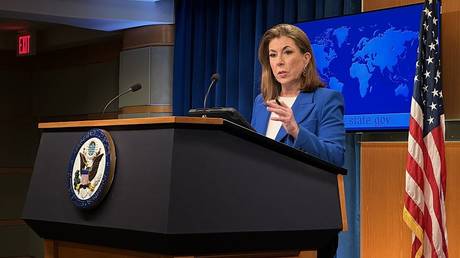 US-Ukraine minerals deal ‘benefits both countries’ – State Department
US-Ukraine minerals deal ‘benefits both countries’ – State Department
However, Ukrainian Economy Minister Yulia Sviridenko said the fund would operate as an “equal partnership,” with neither side having a dominant vote. Ukraine will retain “full control over the resources” – including the subsoil – and will continue to determine the conditions and locations of extraction. The deal also does not transfer any state-owned companies into private hands.
50/50 split
Ukraine will contribute 50% of new rents for new licenses for new extraction to the fund, with the money inside to be invested exclusively in Ukraine. For the first ten years, profits will not be distributed, but will be fully reinvested in the Ukrainian economy, according to the Ministry of Economy. Neither contributions nor profits are taxable.
No security guarantees for Kiev
Conspicuously absent from the deal, however, is any mention of the US providing Ukraine with security guarantees, although this was “one of its initial goals,” as described by Reuters.
Read more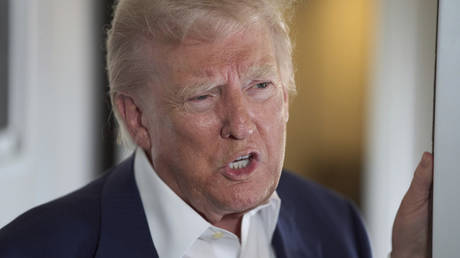 Trump demands Kiev sign minerals deal ‘immediately’
Trump demands Kiev sign minerals deal ‘immediately’
According to the New York Times, the idea of security guarantees was rejected by the US “early in the process.”
Nevertheless, US State Department spokeswoman Tammy Bruce insisted that the deal will strengthen the country’s security: “When America is your friend and your partner, your nation is going to be better off. And there is a security component just in our presence.”
Past US aid not included
The resource deal “focuses on future, not past, US military assistance,” the Ukrainian Economy Ministry has said, adding that revenues from already active projects are not included in the joint investment fund. According to Sviridenko, the agreement “includes no provisions regarding any Ukrainian debt obligations to the United States.”
The US previously portrayed the deal as a way for Ukraine to pay back past military assistance, which the administration of US President Donald Trump estimated at $350 billion. Ukraine has insisted that the past aid was provided unconditionally, while estimating it at $90 billion.
Read more US demanding $100bn compensation from Ukraine – Bloomberg
US demanding $100bn compensation from Ukraine – Bloomberg
Following the signing of the deal, Trump suggested that the US could “in theory” get much more than $350 billion out of the deal.
Initial reactions
US Republican Senator Lindsey Graham described the deal as “tremendously beneficial to the American economy,” adding that it will improve ties between Washington and Kiev.
The New York Times suggested that the “deal will have little significance” if Russia and Ukraine fail to reach a sustainable ceasefire.
Former Russian President Dmitry Medvedev said the US has essentially forced Ukraine to pay for American aid with minerals.
Thorny road to agreement
Negotiations over the agreement dragged on for months, though the sides had planned to sign it in late February during Vladimir Zelensky’s visit to the White House. However, Zelensky’s televised meeting with Trump resulted in a heated exchange, with the US president accusing the Ukrainian leader of ingratitude and “gambling with World War III.” Since then, the US has on several occasions criticized Ukraine for making slow progress on the deal, with Trump at one point demanding that Kiev sign it “immediately.”
-
Site: Catholic Herald
Every Catholic has his or her prediction for the conclave: some predict a new pope in the mould of Pope Francis, others predict a course correction for the Church with the election of a man such as Cardinal Robert Sarah. But if the topic of the conclave has been on everyone’s lips, one question of which I’ve heard little discussion so far has been its length: will the cardinals swiftly return a new pope, or will there be a long, hard fight, with many rounds of balloting before one candidate achieves a two-thirds majority of the electors?
Even the betting markets have neglected this question of the conclave’s length: at the time of writing, users of the betting website Polymarket had staked over $10,000,000 on the identity of the next pope, but only $300,000 on the date of his election. Yet I believe that the most striking feature of this year’s
conclave – the one that historians will remember – could well be that it lasts a very long time.This is because of a little-remarked quirk that Pope Benedict introduced into the rules of conclaves in 2007. It did not become relevant in the one papal conclave held since then, namely the conclave that elected Pope Francis in 2013, but it could well do so in the more contentious election that seems likely this time round, as progressive and traditionalist cardinals fight each other for the future of the Church.
To understand this quirk in the rules, one must go back to the reforms of the conclave promulgated in 1996 by Pope John Paul II with the apostolic constitution Universi Dominici gregis. With this document Pope John Paul II made many radical changes to traditional practice. For example, for the first time in centuries, the cardinals were allowed to live outside the Sistine Chapel complex during the conclave (they are now housed in the Domus Sanctae Marthae). Moreover, the two traditional alternatives to papal election by ballot (per scrutinium) were abolished: namely spontaneous acclamation (whereby the cardinals all shouted the name of their chosen candidate at once, it was assumed at the inspiration of the Holy Spirit), and compromise (whereby the electors delegated a small committee of cardinals to make the choice for them).
But the reform most relevant to the length of the conclave was a further one, and perhaps the most radical of all. If the conclave had failed to elect a pope after 32 rounds of voting (or 33, if one was held on the first day), Pope John Paul II permitted a simple majority of the electors to change the threshold of votes that a man would need to become pope, lowering it from the traditional two-thirds of the electorate to a minimum of 50 per cent plus one.
Although Universi Dominici gregis does not tell us why Pope John Paul created this new rule, it seems likely that he had in mind the sheer workload of the Holy See and the cardinals in the modern world, and the danger that a long conclave might paralyse the Church. He was abolishing election by compromise, which had been the cardinals’ traditional means of ending a long and contentious conclave, and so he wanted give them another means of doing so; hence he devised the new procedure whereby the cardinals might lower the electoral threshold.
After John Paul II’s death, however, as the cardinals gathered for the conclave that would elect Pope Benedict XVI, a problem soon became apparent. If one faction of cardinals could achieve a simple majority for its candidate, it would need only to continue voting for him until round 32 or 33, and then it could force through a reduction of the electoral threshold to a simple majority, and elect him pope. Hence Pope John Paul II had, in effect, reduced the electoral threshold to a simple majority from the very beginning of a conclave – something that he had never meant to do.
Mindful of this problem, in 2007 Pope Benedict issued his own document, De aliquibus mutationibus in normis de electione Romani Pontificis, which modified the procedure to be followed when the cardinals had failed to elect a pope after 32 or 33 rounds. From this point on, only the two cardinals who had received the most votes in the previous round would appear on the cardinals’ ballot papers. But in accordance with tradition, a successful candidate would still need two thirds of the electors’ votes to become pope.
Pope Benedict’s revised rules are still in force, and will govern this year’s conclave. But it is not hard to imagine a situation in which they could cause absolute deadlock. Suppose this year’s conclave were to be split in the ratio 3:2 between cardinals who wanted a second pope Francis, and cardinals who wanted an unabashed traditionalist. The conclave reaches round 33; the heir to Francis receives 50 per cent of the vote, and the traditionalist comes second with 30 per cent. From this point, only these two men remain on the ballot. The cardinals vote again and again, but the traditionalist faction will not elect the heir to Francis; nor will the more progressive cardinals countenance the traditionalist candidate. The cardinals no longer have the option of finding an alternative, compromise candidate. How, at this point, does the conclave end?
Under the rules currently in force, there is simply no answer, and speculation quickly becomes fantastic. Would the Sacred College have to declare itself unable to elect a pope? Might it then have to invite the actual clergy of Rome – the only other body obviously competent to elect a pope – to choose their candidate? What about the cardinals over eighty, scandalously stripped of their voting rights by Pope Paul VI in 1970? And besides these speculative questions, there is an even more fascinating one – why did the brilliant mind of Pope Benedict not foresee this problem of irresolvable electoral deadlock?
At this point, we are heading into the realm of fiction. But one thing is for sure: if this conclave goes beyond round thirty-three, then all bets are off.
RELATED: Cardinal Sarah is the man to save the Church as next pope
Photo: A floodlight points towards St Peter’s Basilica as a sculpture of St Peter holding the key to heaven stands in St Peter’s Square, Vatican, 13 March 2013. At the time, Pope Benedict XVI’s successor was being chosen by the College of Cardinals in Conclave in the Sistine Chapel. (Photo by Peter Macdiarmid/Getty Images.)

The post Could this be the longest conclave in modern history? first appeared on Catholic Herald.
The post Could this be the longest conclave in modern history? appeared first on Catholic Herald.
-
Site: RT - News
The outlet has published a “deliberately false” piece about him, the world’s richest man has said
Elon Musk has branded the Wall Street Journal a “discredit to journalism,” categorically denying the outlet’s claim that Tesla’s board wants to replace him as the CEO of the electric car company.
The WSJ claimed, citing anonymous sources, that about a month ago Tesla’s board reached out to a number of executive search firms to work on a formal process for finding a new CEO. The directors “got serious” after Tesla’s stock plunged and investors got “irritated” by Musk’s focus on his job as the head of the Department of Government Efficiency (DOGE).
Tesla Chair Robyn Denholm issued a statement in which she called the report “absolutely false.”
“The CEO of Tesla is Elon Musk and the board is highly confident in his ability to continue executing on the exciting growth plan ahead,” Denholm stressed.
Read more Most Americans disapprove of Musk’s DOGE performance – poll
Most Americans disapprove of Musk’s DOGE performance – poll
Musk reacted to the report on his X platform on Thursday, insisting that “it is an extremely bad breach of ethics that the Wall Street Journal would publish a deliberately false article” and slammed the outlet for its failure to include the Tesla board’s “unequivocal denial” of claims that it is searching for a new CEO in its article.
In a separate comment, the Tesla and SpaceX CEO labeled the WSJ a “discredit to journalism.”
Tesla suffered a 71% drop in profits and a 9% decline in revenue for the first quarter of 2025, during which time Musk became an increasingly polarizing figure, due to his close ties to US President Donald Trump and his work as the head of the DOGE, an agency tasked with slashing government spending.
Since January, dozens of Tesla-linked locations have been hit by protests, in what Musk claims is a coordinated effort bankrolled by major Democratic donors. There have also been violent attacks, including arson attempts, on the company’s dealerships, vehicles and charging stations.
READ MORE: Robots will outperform human surgeons in five years – Musk
A week ago, Musk announced that he will scale back his government role because the “major work” to establish DOGE has now been completed. During a cabinet meeting on Wednesday, Trump thanked the tech billionaire for his contribution, saying “you know you are invited to stay as long as you want... I guess he wants to get back home to his cars.”
-
Site: Mises InstituteA former toadie to Dick Cheney, sources say Waltz will soon be fired from his job as Trump's National Security Adviser.
-
Site: AsiaNews.itHighly appreciated by Benedict XVI, the archbishop of Sri Lanka's capital has held several posts in the Vatican, including that of secretary of the Dicastery for the liturgy. In recent years, he has accompanied the travails of his country, tirelessly asking for justice for the victims of the Easter 2019 massacres.
-
Site: RT - News
Lindsey Graham says he has wide Senate backing for a bill that includes 500% tariffs on countries buying key Russian exports
US Senator Lindsey Graham has claimed broad Senate support for a bill that would enact “bone-crushing” new sanctions on Russia and impose steep tariffs on countries purchasing its key exports. Graham told reporters on Wednesday that his goal is to support President Donald Trump in negotiations with Russia over a potential Ukraine settlement.
The US imposed extensive sanctions on Moscow since the conflict with Kiev escalated in 2022, targeting financial institutions, trade, and energy exports. While Trump has expressed a desire for mutually beneficial cooperation with Russia, he has also threatened to increase pressure on Moscow, including through sanctions, if he believes it is not negotiating in good faith over Ukraine.
Russia has consistently criticized Western sanctions, calling them illegal, and maintained that they have failed to inflict lasting economic damage. Moscow has also expressed a willingness to resolve the conflict and announced a unilateral three-day ceasefire during Victory Day celebnrations. Kiev, however, rebuked the offer, instead demanding an immediate unconditional 30-day truce.
Read more New sanctions on Russia would mean two more years of war – Rubio
New sanctions on Russia would mean two more years of war – Rubio
“The goal is to help the president… He talked about being frustrated,” Graham told reporters, as cited by Bloomberg. In a post on Truth Social earlier this week, Trump suggested that Russian President Vladimir Putin might not want to stop the war, is “just tapping me along” and may need to be “dealt with differently, through banking or secondary sanctions.”
According to Bloomberg, Graham’s bill includes a ban on US citizens purchasing Russian sovereign debt and a 500% tariff on imports from countries that buy Russian oil, petroleum products, natural gas, and uranium. Graham, a Republican from South Carolina, claimed he has secured the commitment of 72 Senators for his bill, from both parties, and enough support in the House of Representatives to bring it to the floor.
“I want a negotiated end to the war, honorably and just. I think Trump’s the best person to achieve that goal, but these sanctions represent the Senate’s view that we see the primary bad guy being Russia,” the senator stated, calling the bill “a tool in President Trump’s toolbox.”
“When President Trump believes that we’ve reached an impasse, then watch for action,” Graham stated, warning that the measures, if enacted, would “crush” the Russian economy.
READ MORE: Zelensky openly threatening Victory Day terrorist attack – Moscow
The White House did not respond to a Bloomberg request for comment on Graham’s claims. The senator, a veteran foreign policy hawk, has previously called the killing of Russians by Ukrainian troops “the best money” the US had ever spent.
-
Site: Real Investment Advice
When your wealth grows, so does the complexity of your financial life. For high-net-worth individuals, tax planning is no longer just about filing accurately—it’s about strategically managing income, investments, and legacy plans to reduce taxable income and preserve wealth over the long term.
From investment strategies and estate planning to charitable giving and tax-advantaged accounts, smart tax planning can make a significant difference in how much of your wealth stays with you and your heirs. This comprehensive guide explores advanced tax strategies tailored specifically for high-net-worth individuals.
Leveraging Tax-Deferred Accounts
One of the most effective and foundational strategies in tax planning for high-net-worth individuals is the use of tax-deferred accounts. These accounts allow your investments to grow without being taxed each year, offering significant compounding advantages over time. More importantly, they help reduce your current taxable income—a critical factor for individuals in higher tax brackets.
Traditional IRAs and 401(k)s
For salaried professionals and business owners alike, Traditional IRAs and 401(k)s remain valuable tools. Contributions to these accounts are typically made on a pre-tax basis, meaning they reduce your taxable income in the year of the contribution. Over time, the funds grow tax-deferred until withdrawals begin in retirement, when many individuals are in a lower tax bracket. This deferral not only enhances portfolio growth but also provides a strategic timing advantage for tax liability.
SEP IRAs and Solo 401(k)s
For high-net-worth individuals who are self-employed or own small businesses, SEP IRAs (Simplified Employee Pension IRAs) and Solo 401(k)s provide greater contribution flexibility than traditional plans. In 2024, business owners can contribute up to 25% of their compensation or $66,000 (whichever is less) to a SEP IRA. Solo 401(k)s offer the opportunity to contribute both as an employer and an employee, allowing for even greater annual deferrals. These plans are ideal for those with fluctuating income who want to maximize tax advantages during peak earning years.
Defined Benefit Plans
Defined Benefit Plans—also known as pension plans—are less commonly used today but can be highly beneficial for high earners, particularly those in their 50s or 60s who are looking to accelerate retirement savings. These plans allow significantly higher contributions than other retirement plans (sometimes well over $100,000 annually), and the contributions are tax-deductible. This makes them especially appealing for business owners seeking to reduce current income taxes while creating a predictable, fixed income stream in retirement.
By contributing aggressively to these tax-deferred vehicles, high-net-worth individuals can reduce their taxable income during their highest earning years, defer taxes until retirement, and capitalize on compound growth. These strategies also create opportunities for future tax planning, such as Roth conversions during lower-income years or strategic withdrawal planning in retirement to manage required minimum distributions (RMDs).
When integrated into a comprehensive financial plan, tax-deferred accounts become a cornerstone of long-term wealth preservation and tax efficiency.
Roth Conversions for Strategic Tax Diversification
Although Roth IRAs are funded with after-tax dollars, they offer tax-free withdrawals in retirement. A well-timed Roth conversion—moving assets from a traditional IRA to a Roth IRA—can be a powerful tool in years when your income is temporarily lower.
This strategy requires paying taxes on the converted amount now but can minimize future required minimum distributions (RMDs) and lower taxable income in retirement.
Reducing Capital Gains Taxes
Capital gains taxes are a major concern for wealthy investors. Several strategies can help reduce or defer these taxes:
- Tax-loss harvesting: Offset gains by selling underperforming investments.
- Qualified Opportunity Zones: Defer and potentially eliminate capital gains by investing in designated areas.
- Donor-Advised Funds: Donate appreciated assets, avoiding the capital gains tax and receiving a charitable deduction.
Long-term capital gains are taxed at a lower rate than ordinary income, so holding investments for more than a year is another key strategy.
Charitable Giving for Tax Efficiency
Charitable contributions provide more than just philanthropic satisfaction—they offer valuable tax advantages. Consider these methods:
- Donor-Advised Funds (DAFs): Contribute appreciated assets, take a deduction immediately, and distribute funds to charities over time.
- Qualified Charitable Distributions (QCDs): For those over 70½, you can donate up to $100,000 annually directly from an IRA, satisfying RMDs and avoiding income tax.
- Charitable Remainder Trusts (CRTs): These trusts provide income to beneficiaries for a set term, with remaining assets going to charity—delivering both tax benefits and legacy impact.
Trusts and Estate Planning Strategies
High-net-worth individuals must plan carefully for the transfer of wealth. Trusts are essential tools for reducing estate taxes and protecting assets. Common strategies include:
- Irrevocable Life Insurance Trusts (ILITs): Exclude life insurance proceeds from your estate.
- Grantor Retained Annuity Trusts (GRATs): Transfer assets with minimal gift tax implications while retaining an income stream.
- Spousal Lifetime Access Trusts (SLATs): Provide income access while removing assets from the estate.
These tools help manage generational wealth transfer, reduce estate tax liability, and ensure your assets are distributed according to your wishes.
Tax-Efficient Investments
How you invest is just as important as what you invest in. Tax-efficient investments can significantly reduce your tax burden:
- Municipal Bonds: Generate federally tax-free income and, in some cases, are exempt from state taxes.
- Tax-Managed Mutual Funds: Designed to limit capital gains distributions.
- Exchange-Traded Funds (ETFs): Generally more tax-efficient than mutual funds due to their structure.
Strategically placing tax-inefficient investments in tax-advantaged accounts and keeping tax-efficient investments in taxable accounts is known as asset location—an advanced method for reducing taxes over time.
Business Tax Strategies
For business owners, there are additional tax-saving opportunities:
- Pass-Through Entity Deductions: If applicable, Section 199A allows for a 20% deduction on qualified business income.
- S-Corporation Elections: Reduce self-employment tax by splitting salary and distributions.
- Family Employment: Hiring children in the business can shift income to a lower tax bracket.
Working closely with a tax advisor ensures compliance while maximizing deductions and credits available to business owners.
Staying Ahead of Tax Law Changes
Tax laws evolve regularly, and high-net-worth individuals must stay informed to adapt strategies accordingly. Key issues to watch include:
- Changes to estate and gift tax exemptions
- Adjustments to capital gains tax rates
- Proposed legislation affecting retirement accounts and trust rules
Partnering with a financial advisor and CPA allows you to stay proactive and avoid costly surprises.
Ready to Reduce Your Tax Burden and Preserve Wealth?
At RIA Advisors, we specialize in tax planning for high-net-worth individuals. Our team helps you implement custom strategies to reduce taxable income, optimize investments, and protect your legacy. Contact us today to schedule your private consultation and take control of your financial future.
FAQs
What is the best way to reduce taxable income as a high-net-worth individual?
Strategies include maximizing tax-deferred account contributions, leveraging charitable giving, and using tax-efficient investments.
Are Roth conversions worth it for high earners?
Yes—especially in years with lower income or when aiming to reduce future RMDs and taxes in retirement.
How can trusts help with estate tax planning?
Trusts can remove assets from your taxable estate, provide income to beneficiaries, and ensure a smooth asset transfer.
What are tax-managed funds?
These are mutual funds specifically designed to minimize capital gains distributions, making them more tax-efficient for investors.
How do I know if I need advanced tax planning?
If you have a high income, complex assets, or are planning a large legacy, advanced tax planning is essential to preserve wealth.
The post A Comprehensive Guide to Tax Planning for High-Net-Worth Individuals appeared first on RIA.
-
Site: Real Investment Advice
The headlines below lead some to believe the shelves in our stores will soon be empty. Moreover, reminiscent of 2020, an inflation spike due to fractured supply lines is imminent. Let's provide context to help make sense of the headlines and determine whether the plunge of Chinese inbound container ships to US ports represents truth or easy narratives.
- China Freight Ship Traffic To Busiest US Ports Sees Steep Drop – CNBC
- Chief economist warns of collapse after free fall in container traffic to the US -Shipping Watch.
- Traffic At The Port of Los Angeles Set To Plunge- LA Times
- Plunging LA Port Volumes Spell Trouble For Truckers- FreightWaves
As shown on the left, the plunge in traffic of recently departed container ships from Chinese ports is startling. However, it only reverses the surge to US ports in the month prior. As previously noted, companies were stockpiling goods to avoid tariffs. Thus, with inventories higher than usual, importers' needs fell in April, resulting in fewer inbound container ships. The graph on the right shows the two largest California ports where China’s goods typically enter. The recent decline at these ports is no different than so many others in the last 30 years.
Further, even if there is a prolonged slump in goods from China, we must recognize that China ships goods from other countries' ports, like Vietnam, to avoid scrutiny. Thus, total inbound ship traffic is a more critical gauge than ships from Chinese ports.
Even if the supply of goods is curtailed, the inflationary pressure will not rival that of 2021/22. The prior inflation was partly due to diminished supplies, but equally important was the massive stimulus that drove demand. Today, demand is weakening, so half of the inflation recipe is missing.

What To Watch Today
Earnings

Economy

Market Trading Update
Yesterday, we noted that the market had reversed its post-tariff announcement losses. We suggested remaining risk-averse in the near term as the technical damage from the recent decline had yet to be repaired. With the recent 6-day advance in the market, a long stretch, a pullback was likely, particularly as markets approached the 50-DMA. As we have noted recently, many "trapped longs" are looking for an exit, and yesterday those sellers appeared.
One thing we are watching very closely now is oil prices, which remain under pressure. Oil prices are back to pre-pandemic highs, and the risk is a break into the low 50s. The problem with oil is that the President wants to "drill-baby-drill," which will increase supply amid weakening economic demand. Such will result in lower prices, and push-back from oil producers who won't drill low-profitability wells.

However, the decline in oil prices, a significant economic input, was already confirming the slowdown in economic activity we saw in yesterday's GDP report.

Oil prices also confirmed the decline in inflation as shown in yesterday's PCE report.

We continue to watch crude oil for its economic inputs. However, from a purely technical perspective, oil currently has downside to the mid-50s. At those levels, oil will be oversold enough for a decent technical bounce, likely occurring this summer as we move into hurricane season. However, much of that outlook depends on both the supply/demand imbalance in the economy and the dollar. Given that oil trades in dollars, a recovery in the dollar will provide support for oil prices. Our larger concern remains the economic demand component. If that remains sluggish, oil prices could be range-bound in the 50s for quite some time.

We will continue to monitor and make portfolio adjustments accordingly.

GDP, PCE Prices, And ADP
The first quarter GDP fell 0.3% compared to a wide range of estimates. The Wall Street consensus was +0.3%, but the Atlanta Fed GDPNow was -2.8%. While the negative reading is troublesome, the details are not. As shown below, courtesy of Zerohedge, foreign trade subtracted 4.83%. As we note in the opening, this was a function of tariff front running. However, the significant positive contribution from private inventories is also a function of stockpiling. If we subtract those two inputs, GDP would have risen by 2.3%, on par with recent growth.
The ADP jobs report, a precursor for tomorrow's BLS labor report, showed a 62k job gain, well below Wall Street estimates of 135k. The second graph shows that the trend has continually slowed since September. ADP only includes private sector workers, thus the BLS report may also be weak.
Monthly and core PCE prices were 0.0%, 0.1% below expectations. However, last month's figures were revised higher by 0.1%. The year-over-year rate is now 2.3% down from 2.5%, nearing the Fed's 2% target. The Fed will likely look through this month's PCE data and focus more on the next few months which will be impacted by tariffs.


Interest Rate Swaps: The Plumbing Of The Financial System
What are interest rate swaps?
Why are interest rate swap spreads negative?
Why do negative swap spreads warn of a liquidity problem?
To answer these questions, READ MORE...

Tweet of the Day

“Want to achieve better long-term success in managing your portfolio? Here are our 15-trading rules for managing market risks.”
Please subscribe to the daily commentary to receive these updates every morning before the opening bell.
If you found this blog useful, please send it to someone else, share it on social media, or contact us to set up a meeting.
The post Port Plunge Myths: Why Headlines Don’t Tell The Whole Story appeared first on RIA.
-
Site: Crisis Magazine

There was cause for celebration for Catholics in France at this year’s Easter Vigil. Figures released by the Bishops’ Conference of France announced that 10,384 adults would receive the sacrament of baptism at the 2025 Easter Vigil. This is an increase of 45 percent over the 7,135 adults who were baptized in 2024 and a 90 percent increase over the 5,463 adults who were baptized in 2023.
-
Site: Catholic Herald
Each day between now and the May 7 conclave to elect a successor to Pope Francis, we are running a profile of a different “papabile”, the Italian term for a man who could be pope. There’s no precise way to identity these contenders; it’s mostly a matter of weighing reputations, positions held and influence wielded over the years. There’s also certainly no guarantee one of these candidates will emerge wearing white; as an old bit of Roman wisdom has it, “He who enters a conclave as a pope exits as a cardinal.” But these profiles will feature the leading names drawing buzz in Rome right now, at least making it very likely that they will get a look. Knowing who these men are also suggests issues and qualities other cardinals see as desirable heading into the election.
Once upon a time, it was said that the idea of an American pope was unthinkable. In the beginning, it was for basically logistical reasons – steamships from the New World took so long to reach Rome that American cardinals often arrived too late to vote, and in any event they were never part of the political sausage-grinding before the conclave began.
Later, the veto on an American pope became geopolitical. You couldn’t have a “superpower pope”, or so the thinking ran, because too many people around the world would wonder if papal decisions were really being crafted in the Vatican or at CIA headquarters in Langley.
Today, however, that logic feels superannuated. America is no longer the world’s lone superpower, and, in any event, dynamics inside the College of Cardinals have changed. Geography is largely dead as a voting issue; cardinals no longer care what passport a candidate holds, but rather what spiritual, political and personal profile he embodies.
As it happens, there is an American this time round with a serious shot: 69-year-old Cardinal Robert Francis Prevost, who served as head of the Vatican’s ultra-powerful Dicastery for Bishops under Pope Francis for the past two years. That made him responsible for advising the pope on picking new bishops around the world, which is, inter alia, a great way to make friends in the Catholic hierarchy.
As his fellow prelates have gotten to know the former Augustinian superior, many of them like what they see: a moderate, balanced figure, known for solid judgment and a keen capacity to listen, and someone who doesn’t need to pound his chest to be heard.
Born in Chicago in 1955 into a family of Italian, French and Spanish origins, Prevost went to high school at a minor seminary run by the Order of St. Augustine, called the “Augustinians”. From there he enrolled at Villanova University in Philadelphia, eventually earning an undergraduate degree in mathematics in 1977. He joined the Augustinians the same year and began studies at the Catholic Theological Union, where he earned a Master of Divinity degree in 1982. (Prevost is actually the first CTU alumnus to be named a cardinal.)
Next he was shipped off to Rome, where he earned a doctorate degree in canon law from the Dominican-run University of St. Thomas Aquinas, popularly known as the “Angelicum”.
In 1985 Prevost joined the Augustinian mission in Peru. His leadership qualities were quickly recognised, as he was named chancellor of the territorial prelature of Chulucanas from 1985 to 1986. He spent a couple of years back in Chicago as the pastor for vocations for his Augustinian province before returning to Peru, where he would spend the next decade running an Augustinian seminary in Trujillo while also teaching canon law and serving as prefect of studies in the diocesan seminary.
There’s an old rule in clerical life, which is that competence is its own curse – your workload tends to expand in direct proportion to the perception that you’re gifted at getting things done. Thus it was that in addition to his day jobs, Prevost also put in stints as a parish priest, an official at diocesan headquarters, a director of formation for Trujillo and the judicial vicar for the diocese.
Prevost returned to Chicago again in 1999, this time to serve as prior of his province. It was during this period that he would have a brush with the clerical sexual abuse scandals, signing off on a decision to allow an accused priest to reside in a priory close to a school. Though the move would later draw fire from critics, it came before the US bishops adopted new standards in 2002 for handling such cases, and his signature was basically a formality for a deal that had already been worked out between the archdiocese and the accused priest’s spiritual advisor and overseer of a safety plan.
In 2001, Prevost was elected the Prior General of the worldwide Augustinian order, with its headquarters in Rome at the Augustinian Pontifical Patristic Institute, known as the “Augustinianum”, which is located immediately adjacent to St. Peter’s Square and tends to be prime real estate for meeting visiting clergy and bishops from around the world. Prevost would serve two terms in the post, earning a reputation as a deft leader and administrator, before returning briefly to Chicago from 2013 to 2014 as a director of formation for the order.
In November 2014, Pope Francis appointed Prevost apostolic administrator of the Diocese of Chiclayo in Peru, and a year later he became the diocesan bishop. Historically speaking, the Peruvian bishops have been badly divided between a left wing close to the liberation theology movement and a right wing close to Opus Dei. In that volatile mix, Prevost came to be seen as a moderating influence, reflected in the fact that he served on the conference’s permanent council and as vice-president from 2018 to 2023.
This past February, Pope Francis inducted Prevost into the exclusive order of Cardinal Bishops, a clear sign of papal trust and favour – and this despite the fact, according to observers, that Prevost and the late pontiff didn’t always see eye-to-eye; but Francis nevertheless saw in the American prelate a man he felt he could rely upon.
What’s the case for Prevost?
Fundamentally, there are three qualities cardinals look for every time they have to kick the tires on a possible pope: they want a missionary, someone who can put a positive face on the faith; a statesman, someone who can stand on the global stage with the Donald Trumps, Vladimir Putins and Xi Jinpings of the world and hold his own; and a governor, someone who can take control of the Vatican and make the trains run on time, including dealing with its financial crisis.
There’s a solid argument that Prevost ticks all three boxes.
He spent much of his career in Peru as a missionary, and parts of the rest of it in seminary and formation work, giving him an appreciation for what it takes to keep the fires of faith lit. His global experience would be an asset in the challenges of statecraft, and his naturally reserved and equanimous personality might well lend itself to the art of diplomacy. Finally, his successful runs in various leadership positions – religious superior, diocesan bishop and Vatican prefect – offer proof of his capacity to govern.
Moreover, Prevost does not play to classic stereotypes of brash American arrogance. Instead, as both the Italian newspaper La Repubblica and the national TV network RAI recently put it, he comes off as il meno americano tra gli americani, “the least American of the Americans.”
Fundamentally, a vote for Prevost would be seen in broad strokes as a vote for continuity with much of the substance of the Pope Francis agenda, but not necessarily the style, as he’s more pragmatic, cautious and discreet than the late pope – all qualities many of his fellow cardinals might well find desirable.
Moreover, Prevost is seen as having more or less the right age profile. He turns 70 in September, so a Prevost papacy likely would be long enough to guarantee stability, not so long as to conjure images of an Eternal Father instead of a Holy Father.
The case against?
To begin with, Prevost is something of a cypher when it comes to many of the contested issues in Catholic life. In terms of where he stands on matters such as the ordination of women deacons, or the blessing of persons in same-sex unions, or the Latin Mass, he’s played his cards awfully close to his chest. For some cardinals, that might make Prevost too much of a journey into the unknown, especially among more conservative voters who want some guarantee of greater clarity.
In addition, Prevost is among several US cardinals against whom complaints have been lodged by the Survivors Network of Those Abused by Priests (SNAP) for allegedly mishandling abuse complaints. One concerns the accused priest in Chicago, the other two priests in Chiclayo in Peru. There is a compelling other side to that story: multiple parties have defended Prevost’s conduct in both cases, the canon lawyer who initially represented the Peruvian victims is a disgraced ex-priest with an axe to grind, and while in Chiclayo, Prevost was head of a successful diocesan commission for child protection. Still, the mere hint of culpability might be enough to worry some electors.
At a basic level, there may be concern about whether Prevost really has the charisma to play on the global stage, to inspire and to excite. Given that so much of his work over the years has been behind the scenes, he hasn’t had much of an opportunity to turn the world on with his smile. On the other hand, it’s worth recalling that Cardinal Jorge Mario Bergoglio of Argentina had a reputation in Buenos Aires for being a distant, grey figure uncomfortable in the public eye, and we all know how that turned out once he stepped into the Shoes of the Fisherman.
The bottom line is that Prevost satisfies a great deal of what cardinals have traditionally looked for, and even his lack of a clear track record on some disputed issues might be more of an asset than a liability. A 2023 tribute from CTU at the time of his elevation to the College of Cardinals more or less sums up his appeal.
“Prevost brings to the College of Cardinals the heart of a missionary and years of ministerial experience, ranging from academic classrooms to poor barrios to the upper echelons of administration,” it said. “He embodies the Gospel call to be ready to serve wherever the Spirit leads.”
We’ll see in a few days if that strikes at least two-thirds of Prevost’s fellow cardinal electors as the profile of a pope.
Photo: Cardinal Robert Francis Prevost. (Credit: Vatican Media, via Crux.)

The post Papabile of the Day: Cardinal Prevost could be first ‘superpower’ pope for US first appeared on Catholic Herald.
The post Papabile of the Day: Cardinal Prevost could be first ‘superpower’ pope for US appeared first on Catholic Herald.
-
Site: Crisis Magazine

Call it a midlife crisis, call it a dark night of the soul, or call it whatever you like; the last few years have not been kind to me. Failures and regrets have abounded. Severe health crises, several lost pregnancies mid-term, job insecurities, bad investments, and familial stresses have all taken their toll to severely tempt this author to curse God and die. As a former seminarian and…
-
Site: Mises InstituteSecDef says this shows there is "no daylight" between the US and Ukraine. For those wanting the US out of Ukraine, this moves the US in the wrong direction.
-
Site: Catholic Herald
There are moments in history that act as defining dates determining and reflecting the change of direction in world affairs. We think of 1789 and the French Revolution, and of 1917 with the Russian revolution. If you subscribe to the Great Man of History perspective, then there are moments of election and choice that equally offer similar definition.
In the same way that global culture is poised at a hinge moment in history, a version of that crisis is reflected within the Catholic Church and will be given expression to through the election of the next pontiff.
Casual commentators suggest that the choice that lies before the cardinals is placed in one of three categories: going for a conservative, a radical or a compromise moderate. They suggest that a conservative would represent the appointment of a “thin pope after a fat pope”, and that a compromise candidate might offer the solution of eirenic compromise between warring theological factions.
That is a not unreasonable political take on the process. But it misses too much hidden under the surface of the present situation, both theologically and spiritually.
A progressive appointment, a “Francis the Second”, would complete the process that Pope Francis (the First) began more by implication than by action. As Cardinal Tucho pronounced: The Magisterium is dead. Long Live the New Magisterium, the Magisterium of Pope Francis.
In all the argumentation around the extent to which the application of Vatican II represented legitimate continuity with the previous millennia or, rather, a radical discontinuity, the claim that Pope Francis initiated a “new magisterium” is a rather alarming disclosure that the progressive project that he put his weight behind is uncatholic.
And it discloses how a Church that pursues those alternative values – “Who am I to judge” – particularly in relation to sexual ethics, the nature of the family, marriage and celibacy, is so much in breach of the Magisterium that it has had to create a new alternative one (“The Francis magisterium”) as a platform for what would become radical discontinuity.
Can you compromise between Catholic orthodoxy and radical discontinuity?
The question is not very different from asking if you can be a little bit pregnant. There are some compromises that are impossible to give expression to.
Does continuing straight ahead express a compromise between the conflicting choices of going either left or right? If going right is the correct decision, then continuing on ahead is not a compromise between choosing to go left instead. It represents a second directional error, one that will take you to the wrong destination quite as much as the original error.
What we might call orthodox Catholic voices are calling for “a Catholic pope”.
Cardinal Sarah is being favoured by many, in part because he satisfies some of the more justified criteria of progressive liberal values with a commitment to being a Catholic priest and bishop as it has always and everywhere been understood.
 Cardinal Sarah kneels before the Blessed Sacrament in Toronto, Canada (Image from University of St Michael’s College)
Cardinal Sarah kneels before the Blessed Sacrament in Toronto, Canada (Image from University of St Michael’s College)There is a certain irony that a tall, black, dignified African bishop, breaking the mould of white Eurocentric culture as he does, is being presented as a saviour of a Catholic Church that has buckled under Pope Francis from the applied pressure to bless the individual members of gay couples, to watering down the requirements of the teaching on marriage, divorce and access to the sacraments.
When faced with the cultural conflict between the conflicting models of therapy and salvation, Pope Francis deliberately appeared to offer a degree of affirmation to the forces that preferred acceptance and affirmation. His leitmotif of “mercy” implied unconditional acceptance and was recognised as such by a sympathetic press.
RELATED: The media’s selective understanding of a complexed pope
Cardinal Sarah seems to have directly contradicted the therapeutic salve of Pope Francis with classic Catholic teaching when he publicly insisted: “Don’t deceive people with the word ‘mercy’. God forgives sins only if we repent of them.”
On the subject of uncontrolled mass migration, in which Pope Francis adopted the politics of the Left, offering repeated exhortations to “welcome, protect, promote, and integrate” migrants, Cardinal Sarah presented a more coherent Catholic analysis.
It is one rooted in the integrity of the nation and its right to a cohesive self-determining culture. He criticised the progressive assaults promoting mass migration, particularly in relation to its cultural and spiritual impact on Europe:
“The Church cannot cooperate with this new form of slavery that mass migration has become. If the West continues in this fatal way, there is a great risk that, for wanting to welcome everyone, it will no longer be able to welcome anyone.”
(—Cardinal Robert Sarah, interview with French magazine Valeurs Actuelles, March 2019)
Pope Francis varied the rules that governed access to the Eucharist for non-Catholic Christians under certain circumstances, particularly in Germany. A controversial proposal by some German bishops in 2018 was aimed to allow Protestant spouses of Catholics to receive Communion. Cardinal Sarah’s response was to respect and promote normative traditional Catholic teaching on the Eucharist:
“Intercommunion is not allowed between Catholics and non-Catholics. It is not a matter left to national episcopal conferences, nor to individual dioceses, nor to individual priests.”
(—Cardinal Sarah, in a letter to the German bishops, 2018)
Pope Francis commonly expressed a preference for the liturgical reforms of Vatican II, including versus populum celebration of the Mass. Cardinal Sarah’s view was the opposite:
“It is very important that we return as soon as possible to a common orientation, of priests and the faithful turned together in the same direction – eastward or at least towards the apse – to the Lord who comes.”
(—Cardinal Robert Sarah, London, July 2016 [Sacra Liturgia conference])
The deeper question which provides the context for the election of the new pope involves a reconsideration of the exercise that was undertaken by the Second Vatican Council in the heady and confusing days of the 1960s.
At the time, it seemed necessary that some kind of accommodation needed to be reached with the secular culture that was emerging in the second half of the 20th century. Those who believe in progress are still convinced that this accommodation between Church and secular culture was and is necessary.
An alternative view is that what has been unleashed by secular culture is not progress but decadence. And not just ethical entropy; but a decadence that has at its heart a hatred of Christianity in general and of Catholicism in particular; and whose main characteristic is the subversion of the Catholic Church, its anthropology and ethics.Were the cardinals of the Catholic Church to revisit the assessment of the cultural antagonism the Western secular spirit embodies, they might well find both satisfaction and a solution in the choice of Cardinal Sarah.
The combination of being black, being African and being truly and wholeheartedly Catholic might offer just the antidote to the fracture, disorder, ambiguity and discontinuity that the last pontificate has burdened the Church with.
RELATED: Cardinal Müller warns Church risks split if ‘orthodox’ pope not chosen
(Photo by ALBERTO PIZZOLI/AFP via Getty Images.)

The post Cardinal Sarah is the man to save the Church as next pope first appeared on Catholic Herald.
The post Cardinal Sarah is the man to save the Church as next pope appeared first on Catholic Herald.
-
Site: Mises InstituteHistorian Chris Calton joins Ryan McMaken to discuss both the upsides and the downsides of Trump's first 100 days.
-
Site: AsiaNews.itIt was supposed to be a land of promises for those who had always lived from subsistence farming. Thanks to the employment brought by the mine, they had access to modern education and healthcare. But the end of the licence and a vicious cycle of tribal struggles have sown death and desolation. The government of Papua New Guinea has recently negotiated the mine's reopening. But with many unknowns about the future.
-
Site: RT - News
Spokeswoman Tammy Bruce has said the deal is “perfect” because it was crafted by President Donald Trump
The minerals deal granting the US access to Ukraine’s natural resources benefits both nations, State Department spokeswoman Tammy Bruce said on Thursday. Speaking to Fox Business, she described the agreement as “perfect” because it was crafted by President Donald Trump, citing his business experience.
Washington and Kiev signed the long-anticipated agreement on Wednesday. While the full text has not been made public, the available details suggest that it allocates part of the revenues from resource development to a joint US-Ukraine investment fund, while Kiev retains full ownership of the actual resources. Kiev hopes the deal will secure continued military and financial support from Washington, while the US gains access to Ukraine’s vast mineral wealth, particularly rare-earth elements critical for high-tech industries.
“A lot of people have wanted this to happen. It benefits both countries immensely… and it’s not a surprise because it’s President Donald Trump, it is the perfect deal,” Bruce said. She did not provide further details on the agreement but described it as “an investment in Ukraine.”
Read more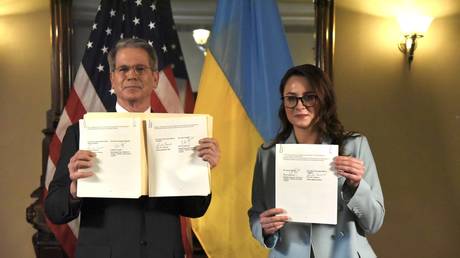 Ukraine and US sign much-awaited minerals deal: As it happened
Ukraine and US sign much-awaited minerals deal: As it happened
“This is about a long-term durable dynamic regarding an economic partnership with that nation, which is necessary in general,” she said. Bruce added that a US presence in Ukraine would also enhance the country’s security.
“When America is your friend and America is your partner, your nation is going to be better off, your citizens are going to be better off, and there is a security component just in our presence,” she stated.
Bruce stressed that the deal is “separate” from the ongoing conflict and US-Russia peace negotiations, but said work on the talks is progressing, with Moscow and Kiev expected to submit proposals “in a few days.”
Negotiations on the minerals deal have been underway since the early days of Trump’s return to office, running parallel to broader peace efforts. The Trump administration has insisted that the deal should compensate the US for previous aid to Ukraine, despite Kiev’s claims that the assistance was given unconditionally.
-
Site: Mises InstituteIn any society, there are winners. But how do they win? Successful entrepreneurs innovate, take risks, and satisfy consumer needs in a competitive marketplace.
-
Site: Zero HedgeStrategic Implications Of North Korea's Expanding Naval AmbitionsTyler Durden Thu, 05/01/2025 - 02:00
Authored by Jihoon Yu via RealClearDefense,
North Korea's recent unveiling of the Choe Hyon-class multipurpose destroyer signals a major transformation in its naval strategy, carrying profound and complex implications for regional and global security. The construction of this 5,000-ton warship marks a deliberate departure from Pyongyang's traditional coastal defense doctrine, historically centered around small, fast attack craft optimized for littoral engagements. Instead, the new platform reflects an ambition to project power across broader maritime domains, signaling a strategic evolution towards an expeditionary, blue-water navy.
The enhanced operational radius provided by the Choe Hyon-class destroyer enables North Korea to extend its naval presence well beyond the Korean Peninsula, threatening key maritime routes and complicating the operational calculus of South Korea, Japan, and the United States. If this platform eventually secures the ability to launch nuclear-armed ballistic and cruise missiles, it would represent a transformative leap in Pyongyang's deterrence posture. Equipped with vertical launch system (VLS), the destroyer could then field a diverse arsenal capable of targeting both land and sea-based assets across considerable distances, significantly elevating the strategic risks in the region.
If North Korea's ongoing efforts to enhance its nuclear capabilities eventually lead to the deployment of nuclear warheads on this platform, the strategic landscape would be further destabilized. Sea-based nuclear platforms would introduce a new layer of strategic complexity. Unlike land-based missile systems, which are more readily tracked and targeted, mobile maritime platforms are inherently more elusive, complicating preemptive strike options and missile defense architectures. This mobility would grant North Korea a potent second-strike capability, eroding confidence in the stability of existing deterrence frameworks. As a result, adversaries may face greater difficulty in distinguishing between conventional and nuclear threats during a crisis, increasing the risk of inadvertent escalation.
The strategic implications would become even more acute if North Korea succeeds in complementing this surface capability with the acquisition of nuclear-powered submarines (SSNs) capable of launching submarine-launched ballistic missiles (SLBMs). Should Pyongyang succeed in fielding a credible SSBN (ballistic missile submarine) fleet, it would possess a survivable nuclear deterrent, fundamentally altering the strategic balance in Northeast Asia. Reports suggest that North Korea's SSN program has received clandestine assistance, possibly from Russia, accelerating its timeline and technological sophistication.
The unveiling of the Choe Hyon-class destroyer must also be seen within the broader context of North Korea's doctrinal shift toward proactive military operations. Moving away from a historically reactive defense posture, Pyongyang appears increasingly willing to embrace preemptive, offensive maritime strategies aimed at undermining U.S. and allied freedom of navigation in the region. This trajectory raises the possibility of North Korea seeking to impose a regional anti-access/area-denial (A2/AD) strategy, leveraging both land- and sea-based assets to constrain allied operational flexibility in a crisis.
Such developments risk fueling a maritime arms race in Northeast Asia, prompting South Korea, Japan, and the United States to accelerate investments in naval modernization, undersea warfare capabilities, and integrated missile defenses. Yet simply matching North Korea platform-for-platform would be insufficient. Addressing the broader strategic challenge requires a comprehensive approach that enhances maritime domain awareness, strengthens alliance interoperability, and builds layered missile defenses capable of countering both conventional and nuclear threats. Enhanced investment in anti-submarine warfare (ASW) capabilities, the deployment of more resilient undersea surveillance systems, the expansion of joint maritime exercises, and the establishment of rapid-reaction maritime forces will also be critical to preempt and deter potential provocations. In particular, South Korea should seriously consider pursuing its own nuclear-powered submarine program to enhance its underwater operational endurance and strategic deterrence, thereby reinforcing its ability to respond flexibly to the evolving undersea threat environment.
Ultimately, the deployment of advanced platforms like the Choe Hyon-class destroyer reflects not merely a technical upgrade, but a profound recalibration of North Korea's strategic ambitions. Pyongyang is no longer content to deter adversaries solely through the threat of land-based nuclear retaliation; it seeks to establish itself as a maritime power capable of projecting coercive influence across the Indo-Pacific. If left unaddressed, North Korea's evolving naval capabilities could significantly erode regional stability and embolden Pyongyang's broader strategic calculus. A coordinated, multidimensional response from the United States, South Korea, Japan, and other regional stakeholders—encompassing deterrence, defense, diplomacy, and sustained pressure on North Korea's illicit networks—is urgently required to mitigate these emerging threats and preserve a credible deterrence posture.
Jihoon Yu is a research fellow and the director of external cooperation at the Korea Institute for Defense Analyses. Jihoon was the member of Task Force for South Korea’s light aircraft carrier project and Jangbogo-III submarine project. He is the main author of the ROK Navy’s Navy Vision 2045. His area of expertise includes the ROK-US alliance, the ROK-Europe security cooperation, inter-Korean relations, national security, maritime security, and maritime strategy. He earned his MA in National Security Affairs from the US Naval Postgraduate School and PhD in Political Science from Syracuse University.
-
Site: RT - News
Keith Kellogg has said Kiev wants to hold the current front line
Kiev has agreed to acknowledge Russia’s control over Crimea and four other regions – without formally recognizing Moscow’s sovereignty over them – according to US President Donald Trump’s special envoy, Keith Kellogg.
In an interview on Wednesday, Fox News anchor Martha MacCallum asked Kellogg whether the US could accept Moscow’s demand that Ukraine renounce claims to territories it considers to be under Russian occupation.
“Partially, yes,” Kellogg replied. “Look, the Ukrainians, Martha, have already said – they’re willing to give up the land… not de jure – forever – but de facto because the Russians actually occupied it. They’ve agreed to that,” he said. “They told me that last week.”
Kellogg added that Ukraine wants a ceasefire that would mean “you sit on the ground that you currently hold.”
Read more Dmitry Trenin: Here’s why Trump’s foreign policy is calculated, not chaotic
Dmitry Trenin: Here’s why Trump’s foreign policy is calculated, not chaotic
The envoy said he met with Ukrainian officials in London on April 23 and that they had agreed to “22 concrete terms” presented by the US, including a 30-day comprehensive ceasefire. He urged Moscow to “pick up on” the proposal.
Russia, however, has maintained that a full ceasefire would require Ukraine to halt its mobilization campaign and stop accepting military aid from abroad. President Vladimir Putin has also demanded that Kiev withdraw from the Russian territories it still claims. Moscow has accused Ukraine of repeatedly violating a 30-day ‘energy truce’ brokered by Trump in March, as well as last month’s 30-hour Easter truce.
Crimea voted to secede from Ukraine and join Russia shortly after the 2014 US-backed coup in Kiev. The Donbass republics of Donetsk and Lugansk, along with the regions of Kherson and Zaporozhye, followed suit after referendums in 2022.
The agreement proposed by Washington reportedly includes US recognition of Russian sovereignty over Crimea, freezing the conflict along the current front lines, and acknowledging Moscow’s control over large parts of the four other former Ukrainian regions. The deal would also reportedly block Ukraine from joining NATO and initiate a phased removal of the sanctions on Russia.
-
Site: AntiWar.comEight years before the U.S.-backed regime in South Vietnam collapsed, I stood with high school friends at Manhattan’s Penn Station on the night of April 15, 1967, waiting for a train back to Washington after attending the era’s largest antiwar protest so far. An early edition of the next day’s New York Times arrived on … Continue reading "The Vietnam and Gaza Wars Shattered Young Illusions About US Leaders"
-
Site: The Unz ReviewThis video is available on Rumble, Bitchute, Odysee, Telegram, and X. Last week, Heather Mac Donald, who is one of the best people in mainstream media, wrote this: “Trump Takes His Biggest Step Yet Toward Restoring Meritocracy.” He had just signed this executive order, which bans a pernicious legal doctrine called “disparate impact.” This terrible,...
-
Site: The Unz ReviewAbout a month or so ago on March 23 I posted on this website my memoir of my time in the Reagan administration which had just been published in The Independent Review, a readable quarterly. I expected to hear more than I did in response to my memoir, because I spelled out how difficult it...
-
Site: AntiWar.comTo conquer a place is to fundamentally subdue its population. This must be clearly differentiated from ‘occupation’, a specific legal term that governs the relationship between a foreign “occupying power” and the occupied nation under international law, particularly the Fourth Geneva Convention. When Israeli forces were ultimately compelled to redeploy from the Gaza Strip in … Continue reading "The Myth of Conquest: Why Gaza Will Never Be Subdued by Israel"
-
Site: The Unz ReviewThe administration of U.S. President Donald Trump—and many of his most prominent right-wing supporters—are directly linked to some of the most radically pro-war, pro-Israel organizations in the country. These connections form a sprawling web of lobbying groups, tech billionaires, and media figures who consistently promote Israeli interests above those of ordinary Americans. Why has the...
-
Site: AntiWar.comIn 1958, Soviet intellectuals Alexander Yakovlev and Oleg Kalugin arrived at Columbia University as Fulbright scholars for a year of graduate studies. They weren’t defectors. They were loyal Party apparatchiks, sent to study how America’s “propaganda machine” worked so they could better defend socialism back home. Instead, they encountered something far more dangerous to totalitarianism … Continue reading "The Marketplace of Ideas Only Works If We Leave the Doors Open"
-
Site: The Unz ReviewRumble link Bitchute link Since YouTube nuked my channel three years ago, and since many people have contacted me looking for my “War on Islam” video with Richard Gage and Christopher Bollyn, I am reposting it at my Rumble and Bitchute channels. You can read a transcript at my Substack by clicking “transcript” above the...
-
Site: The Unz ReviewMy Dear Friends, It’s a hard time to be a liberal. I know, because I used to be one. Or rather, I still am one, but a true liberal, unlike the many fake liberals out there. Allow me to explain. Long ago, as an idealistic college student, I valued my high moral principles, my faith...
-
Site: The Unz Reviewight years before the U.S.-backed regime in South Vietnam collapsed, I stood with high school friends at Manhattan’s Penn Station on the night of April 15, 1967, waiting for a train back to Washington after attending the era’s largest anti-war protest so far. An early edition of the next day’s New York Times arrived on...
-
Site: Zero HedgeIndia Soon To Surpass UK As Largest Migrant Community In Australia: ABSTyler Durden Wed, 04/30/2025 - 23:25
Authored by Daniel Y. Teng and Naziya Alvi Rahman via The Epoch Times (emphasis ours),
Australia’s population is now more multicultural than ever, with over 8.6 million residents born overseas—about 31.5 percent of the total population.
 A young boy enjoys the Diwali light show put on by residents of Phantom Street, Nirimba Fields in western Sydney on Nov. 1, 2024. Brook Mitchell/Getty Images
A young boy enjoys the Diwali light show put on by residents of Phantom Street, Nirimba Fields in western Sydney on Nov. 1, 2024. Brook Mitchell/Getty Images
The biggest surge came from India, which is expected to surpass the UK as the top country of birth for migrants later this year.
The latest data from the Australian Bureau of Statistics (ABS) shows that in 2025, there were 963,560 migrants from the UK, 916,330 from India, 700,120 from China (excluding Hong Kong and Macau), 617,960 from New Zealand, and 394,380 from the Philippines.
This was followed by Vietnam (318,760), South Africa (224,160), Nepal (197,800), Malaysia (183,490), and Sri Lanka (172,800).
Overall, the proportion of overseas migrants has steadily increased over recent decades from 23.8 percent in 2004 to 31.5 percent in 2024.
Globally, Australia ranked eighth in terms of the number of international migrants. The United States topped the list with 52.4 million overseas-born residents.
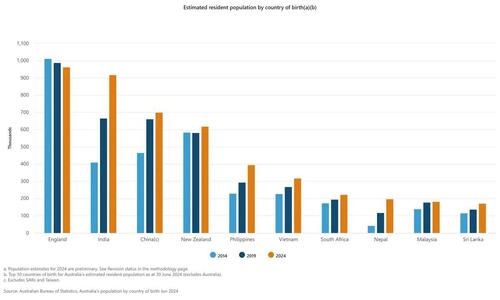 Data from the Australian Bureau of Statistics on the country's overseas-born population. ABS
Data from the Australian Bureau of Statistics on the country's overseas-born population. ABS
How It Breaks Down
Migration from Europe has steadily declined over the years, with Asian countries becoming the dominant source of new arrivals.
India migration has continued to surge with an additional 505,000 people entering Australia in the decade from 2014 to 2024, followed by China (234,000), the Philippines (164,000), and Nepal (155,000).
“India’s demographics, coupled with its skilled workforce and a high demand for international education, have made Australia a preferred destination,” said Annathurai Gnanasambandam, director of Visa Help Australia, in an interview with The Epoch Times.
On the flipside, the UK recorded the largest decrease in migrants, with 47,000 fewer individuals entering Australia from 2014 to 2024, followed by Italy (44,000), Greece (28,000), and Germany (18,000).
The average median age of European migrants is 60 years and over, reflecting the post-World War II migration trend.
Which Cities?
The demographic make-up of each state and territory differs as well.
In New South Wales, Chinese migrants were the largest source of overseas residents, followed by the British and Indians, according to the 2021 Census.
In Victoria, Indian migration was the largest by far, outstripping Chinese migration by about 90,000 individuals.
In Queensland, New Zealanders and British were the largest overseas communities, followed by Indians and Chinese.
The British were the biggest contributors to Western Australia and Tasmania.
Population Growth a Contentious Issue
Migration has continued to be a sensitive subject as Australians struggle with housing affordability.
The Coalition has accused the Albanese government of mismanaging immigration, with net overseas migration for 2023–24 forecast to reach 340,000—80,000 higher than initial estimates.
Shadow Immigration Minister Dan Tehan blamed Labor for “consistently overshooting” forecasts and pledged to cut permanent migration from 185,000 to 140,000 if elected.
But Treasurer Jim Chalmers defended the government’s position, pointing out that net migration was declining.
“It’s now at its lowest point since the pandemic,” he said, adding the system is being rebalanced to serve Australia’s national interest.
-
Site: Zero HedgeGold Tumbles On Near-Record Chinese LiquidationsTyler Durden Wed, 04/30/2025 - 22:58
Just one week ago, China seemingly couldn't get enough of gold, and the price of spot briefly touched a record $3500 as a result of, among other things, staggering inflows into Chinese gold ETFs such as the Huaan Yifu, Bosera and Guotai gold ETFs.
But, as with all things momentum-based in China, it's easy come, easy go in the land of Dragons, and as Goldman commodity trader Adam Gillard writes, China liquidated what it bought last week ahead of the Labor Day holiday, resulting in total onshore positioning now 5% off the ATH. And while China’s share of total open interest remains on the highs at ~40%, upward momentum may have peaked for the time being.
Here is the story of Chinese gold buying... and then selling, in five charts.
Last Tuesday (22nd April) gold made an ATH as China added 1.2mn oz of positioning across SGE and SHFE, on record volume....
... so fast forward to today, when China liquidated a near-record 1mn oz across SHFE and SGE, reversing the entire April 22 blow-off top.
... although the ETF was largely unchanged
... Resulting in total Chinese positioning now ~5% off the ATH .
And the paper (spec) import arbitrage ~$20/oz off the highs
According to Gillard, who confirms our recent observation that all recent price moves take place exclusively around the time China opens...
China opens and gold soars to new record high https://t.co/z61bLLj4Y9 pic.twitter.com/bwLH49On8X
— zerohedge (@zerohedge) April 16, 2025... China is having a disproportionate impact on price because they execute during an illiquid part of the day (Asia morning) which likely triggers ex China CTA trading signals. Sure enough, gold is dumping in early Asian trading to the lowest level in 2 weeks.
More int the full Goldman note available to pro subs.
-
Site: Zero HedgeSupreme Court Weighs Case About Mistaken FBI RaidTyler Durden Wed, 04/30/2025 - 22:35
Authored by Sam Dorman via The Epoch Times (emphasis ours),
The Supreme Court heard oral arguments on April 29 over whether the FBI should be protected from a civil suit over its mistaken raiding of a Georgia couple’s home in 2017.
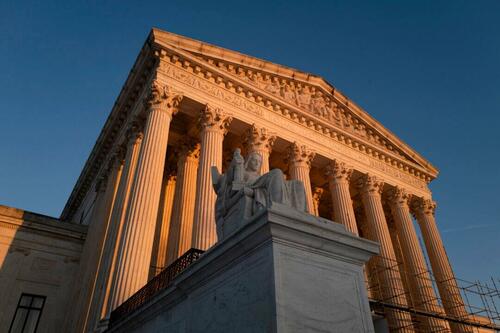 The U.S. Supreme Court building in Washington on Feb. 10, 2025. Madalina Vasiliu/The Epoch Times
The U.S. Supreme Court building in Washington on Feb. 10, 2025. Madalina Vasiliu/The Epoch Times
In the early morning hours of Oct. 18, 2017, FBI Special Agent Lawrence Guerra mistakenly believed he had arrived at a gang member’s home to execute a search warrant. Instead, he smashed through the door of a different home—that of Hilliard Toi Cliatt and his partner, Curtrina Martin.
According to their petition to the Supreme Court, Cliatt pulled Martin into a walk-in closet while her 7-year-old son hid under his bed covers. Guerra eventually realized he had gone to the wrong address, and after raiding the correct home, returned to apologize at the home he had mistakenly raided.
Although Guerra had conducted a pre-dawn drive-by in preparation, court filings state that the GPS directed them to a different home. The address of Cliatt’s and Martin’s home was not on the house itself but was instead on the mailbox and “is not visible from the street,” according to the Justice Department’s filing.
During oral arguments on April 29, the Supreme Court weighed whether Martin and Cliatt should be able to sue the government. A law known as the Federal Tort Claims Act generally allows individuals to sue the government for certain acts, such as assault, false arrest, or abuse of process. It includes an exception, however, for legal claims involving the government’s discretion in performing a particular duty or function.
This was the caveat the U.S. Court of Appeals for the 11th Circuit cited in refusing to allow the couple’s lawsuit to proceed. Martin and Cliatt, however, pointed to a provision added to the law in 1974 after mistaken raids in Collinsville, Illinois. That provision allowed legal arguments by plaintiffs based on “acts or omissions of investigative or law enforcement officers of the United States Government.”
The justices’ line of questioning on April 29 indicated they would remand or send the case back to the appeals court with a narrow win for the couple that entailed more consideration by another judge.
At one point, Justice Neil Gorsuch seemed incredulous at some of the comments made by Assistant to the Solicitor General Frederick Liu, who suggested that the FBI agents’ mistakes were protected as an attempt to exercise discretion. Liu argued that because there was no specific policy directing the FBI agent not to search a house other than the suspect’s, he retained some level of legal protection.
“No policy says don’t break down the wrong house—door of a house ... don’t traumatize its occupants, really?” Gorsuch asked.
Liu said that while the United States’ policy “of course” is to execute warrants at the correct house, “stating the policy at that high level of generality doesn’t foreclose or prescribe any particular action and how an officer goes about identifying the right house.” He went on to suggest that officers may need to consider things such as public safety and efficiency when determining whether to take an “extra precaution” to ensure they’re at the right house.
Gorsuch interjected, saying, “You might look at the address of the house before you knock down the door.”
“Yes,” Liu responded, adding, “that sort of decision is filled with policy tradeoffs.”
Gorsch interrupted, asking, “Really?”
After Liu said that checking the house number at the end of the driveway could expose agents to potential lines of fire, Gorsuch asked, “How about making sure you’re on the right street ... checking the street sign? Is that too much?”
Liu told Justice Sonia Sotomayor that the 1974 addition removed one layer of protection for officers but allowed another layer to stay in place.
“That is so ridiculous,” Sotomayor said. “Congress is looking at the Collinsville raid and providing a remedy to people who have been wrongfully raided, and you’re now saying, no, they really didn’t want to protect them fully.”
-
Site: RT - News
The journalist has said it is “obvious” that Kiev was behind the plot to kill the US president in Florida
Ukraine was involved in a plot to assassinate US President Donald Trump during his 2024 reelection campaign, American journalist Tucker Carlson has claimed.
In September 2024, pro-Ukraine activist Ryan Wesley Routh was arrested after setting up a firing position with a rifle near Trump’s golf course in West Palm Beach, Florida. He was spotted by Secret Service agents before he could open fire and was detained following a brief manhunt.
“It’s very obvious that the Ukrainians were involved in the attempted assassination on the golf course in Florida,” Carlson said on the Megyn Kelly Show on Tuesday.
“That guy definitely had some contact with Ukraine, for sure,” Kelly replied. “He was in Ukraine!” Carlson stressed.
Kelly said Routh was “asking them” for heavy weaponry, including rocket-propelled grenades. Carlson agreed and suggested that Kiev may have been involved in other assassination plots.
“I know for a fact there were others who were a target of assassination attempts by the Ukrainian government,” he claimed, without providing details.
Read more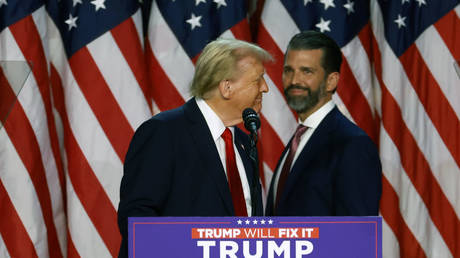 Trump Jr. demands answers from Ukraine over alleged assassination plot
Trump Jr. demands answers from Ukraine over alleged assassination plot
According to court documents from the Southern District of Florida, Routh – a convicted felon – attempted unsuccessfully to enlist in the Ukrainian army in 2022. Despite this, he allegedly worked to recruit foreign volunteers for the Ukrainian military.
Prosecutors allege that Routh attempted to purchase either a rocket-propelled grenade launcher or a Stinger man-portable air-defense missile from a Ukrainian associate. “I need equipment so that Trump don’t [sic] get elected,” he wrote in one of the encrypted messages cited in the case.
Both weapons systems have seen extensive use in the Ukraine conflict. “One missing would not be noticed,” Routh reportedly said in another message.
In 2022, Routh took part in a rally in Kiev in support of Ukraine’s Azov military unit, whose fighters were under siege by Russian forces in Mariupol at the time. The unit – which includes members with neo-Nazi and ultranationalist backgrounds – later stated that Routh “has never had any connection to Azov.”
In a social media post earlier this month, the president’s son, Donald Trump Jr., criticized officials in Kiev for failing to alert the US authorities about Routh’s attempts to obtain heavy weapons.
The Florida incident came after a separate assassination attempt in July 2024, when a gunman opened fire during a Trump campaign rally in Pennsylvania. Trump was escorted from the stage after a bullet grazed his ear. One spectator was killed and several others were wounded. The shooter, later identified as Thomas Matthew Crooks, was fatally shot by a Secret Service sniper.
-
Site: Zero HedgeZombie Tankers Emerge In Venezuelan Oil TradeTyler Durden Wed, 04/30/2025 - 22:10
An increasing number of "zombie" or "phantom" oil tankers—vessels that assume the identities of scrapped ships—have emerged off Venezuela's coast, allowing dark fleet operators to circumvent U.S. trade restrictions on global oil transport.
According to a Bloomberg report, one of these zombie tankers was recently spotted off the waters of Malaysia after a two-month voyage from Venezuela, raising many red flags.
The report describes how dark fleet operators transform tankers into floating zombies:
The vessel raised some red flags: it was 32 years old, past the age at which it would normally have been scrapped, and it was sailing under the flag of Comoros, a popular flag of convenience that makes ships harder to monitor.
For all intents and purposes, though, it seemed like any other so-called dark fleet tanker that carries barrels of sometimes sanctioned oil from producers like Russia, Iran and Venezuela. Except it wasn't.
The real Varada, which wasn't sanctioned, had actually been demolished in Bangladesh in 2017. This vessel was what's known as a zombie or phantom ship, which take on the identities of scrapped tankers to appear legitimate and avoid scrutiny from authorities in the U.S. and elsewhere.
Bloomberg investigators obtained ship-tracking data and satellite imagery showing that at least four zombie tankers have been involved in the Venezuelan oil trade with Asia. At the same time, the Trump administration ramped up maximum pressure, forcing Western oil firms to withdraw from the country.
Last week, John Hurley, a hedge fund veteran who's been nominated to lead the Treasury Department's terrorism and financial intelligence arm, warned about "consequences" for any nation that purchases Venezuelan oil.
Hurley would enforce President Trump's executive order, which could impose 25% tariffs on countries that purchase crude from Venezuela.
"President Trump is sending a clear message that access to our economy is a privilege, not a right, and countries importing Venezuelan oil will face consequences," Hurley wrote in responses to questions from the U.S. Senate Banking Committee.
Bloomberg first reported zombie tankers in September and November last year, and maritime intelligence analysts have been paying attention.
"Zombie ships are the third way," Starboard analyst Mark Douglas said, adding, "The thinking is like: 'I can't afford to run my own system, so I'll use another ship's identity to get that oil from point A to point B.'"
Using a dark fleet network and zombie tankers, China has quietly become the largest buyer of Venezuelan oil. Perhaps tariffs alone will fall short—maybe Hurley's strategy will involve slapping Beijing in the face with sanctions.
-
Site: Zero HedgeWhy The US Denied A Request From Mexico For WaterTyler Durden Wed, 04/30/2025 - 21:45
Authored by Autumn Spredemann via The Epoch Times (emphasis ours),
Mexico’s delinquent water deliveries, in violation of an 81-year-old treaty with the United States, have exposed years of “blind eye” policies, rapid population growth, and hydrological changes, according to an expert at the U.S. Army War College.
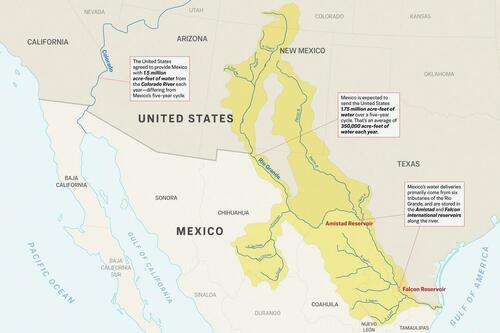 Illustration by The Epoch Times, Shutterstock
Illustration by The Epoch Times, Shutterstock
Evan Ellis, research professor of Latin American studies at the college’s Strategic Studies Institute, told The Epoch Times that recent tensions over Mexico’s delinquent water deliveries have come from “years of looking the other way” on the part of the United States.
U.S. President Donald Trump has requested that the United States’ southern neighbor honor its obligation to deliver 1.3 million acre-feet of water to Texas. The amount totals almost 70 percent of a five-year water commitment that’s due in October.
“Just last month, I halted water shipments to Tijuana until Mexico complies with the 1944 Water Treaty,” Trump wrote in an April 10 post on his social media platform, Truth Social.
Under the reciprocal agreement, Mexico is expected to send the United States 1.75 million acre-feet of water over a five-year cycle. That’s an average of 350,000 acre-feet of water each year. The water deliveries primarily come from six tributaries of the Rio Grande, and are stored in the Amistad and Falcon international reservoirs along the river.
One acre-foot of water—one acre of water at a depth of one foot—is roughly enough to fill half of an Olympic-size swimming pool. Mexico’s average annual obligation is enough water to supply 700,000 to 1 million Texas households for a year.
In exchange, the United States agreed to provide Mexico with 1.5 million acre-feet of water from the Colorado River each year—differing from Mexico’s five-year cycle.
The Tijuana shipments that Trump said were halted were part of a non-treaty water request from Mexico.
The U.S. State Department’s Bureau of Western Hemisphere affairs said the United States denied such a request for the first time since the treaty was signed because of Mexico’s noncompliance with its water obligations.
“Mexico’s continued shortfalls in its water deliveries under the 1944 water-sharing treaty are decimating American agriculture—particularly farmers in the Rio Grande valley,” the State Department wrote in a statement on social media platform X on March 20.
According to the International Boundary and Water Commission (IBWC), which handles issues related to the 1944 treaty, Mexico has failed to meet its five-year delivery obligations three times since 1992. Each of those debts was carried over to the following cycle and ultimately paid.
Mexico also fell short in average minimum annual deliveries within the 2002–2007 and the 2015–2020 cycles. Those shortfalls were met very close to the end of the cycles—in 2020, within just three days of the deadline.
Although the deliveries were ultimately fulfilled, the unpredictable nature of water deliveries from the Rio Grande has impacted water users on both sides of the border.
The current cycle for both countries ends in October, but according to IBWC data, by March 29, just 28 percent—or less than 500,000 acre-feet of water—of Mexico’s water obligation had been delivered.
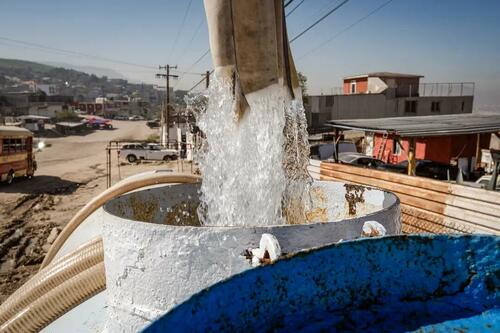 A water delivery truck loads water for sale in Tijuana, Mexico, on March 24, 2025. On March 20, the United States announced it denied Mexico’s request for Colorado River water, pressuring the country to meet its obligation to deliver 1.3 million acre-feet of water to Texas under the 1944 Water Treaty. Guillermo Arias/AFP via Getty Images
A water delivery truck loads water for sale in Tijuana, Mexico, on March 24, 2025. On March 20, the United States announced it denied Mexico’s request for Colorado River water, pressuring the country to meet its obligation to deliver 1.3 million acre-feet of water to Texas under the 1944 Water Treaty. Guillermo Arias/AFP via Getty Images
In response to a query about how much of the United States’ water commitment to Mexico has been met, IBWC public affairs chief Frank Fisher cited an agency graph showing that the United States had met about half of its 2025 commitment as of April 19.
In November 2024, the two countries agreed to a treaty amendment that would give Mexico more ways to meet its water obligation. Those options include providing water from the San Juan and Alamo rivers, which are not part of the Rio Grande tributaries specified in the treaty. The agreement also set up a working group to explore other sources of water.
Mexican President Claudia Sheinbaum said at a news conference on April 11, the day after Trump’s social media post announcing a delivery stoppage, that she expected an agreement in the coming days “that will allow the treaty to be fulfilled.” She called the treaty “fair.”
Sheinbaum told reporters that there would be “an immediate delivery of a certain number of millions of cubic meters that can be provided according to the water availability in the Rio Grande.”
In response to a query about whether Mexico had made that delivery, the State Department confirmed that Mexico had committed to making an immediate transfer of water, but it did not confirm that the delivery had been made.
The State Department stated on April 28 that the two countries had committed to developing “a long-term plan to reliably meet treaty requirements while addressing outstanding water debts—including through additional monthly transfers and regular consultations on water deliveries that take into consideration the needs of Texas users.”
Sheinbaum has blamed her country’s increasingly delinquent water shipments on extended periods of drought that have affected the Rio Grande.
“Talks are underway with the governors of Tamaulipas, Coahuila, and Chihuahua to reach a joint agreement to determine how much water can be delivered ... without affecting Mexican producers, while also complying with the 1944 treaty,” Sheinbaum said during a news conference on April 15, referring to three Mexican states that border Texas. The Rio Grande serves as the international boundary.
Historically, Mexican farmers have contested attempts to increase water deliveries to the United States for fear of losing their crops.
In September 2020—before an October delivery deadline—farmers in Mexico’s Chihuahua state, which borders New Mexico and Texas, were involved in heated protests over government attempts to deliver 378 cubic meters of water to the United States, claiming that their livelihoods were at stake amid severe drought conditions. One protester was killed in clashes with the Mexican National Guard.
 Sculptures stand along the international boundary at Amistad Reservoir on the U.S.–Mexico border near Ciudad Acuña, Mexico, on Feb. 21, 2017. Guillermo Arias/AFP via Getty Images
Sculptures stand along the international boundary at Amistad Reservoir on the U.S.–Mexico border near Ciudad Acuña, Mexico, on Feb. 21, 2017. Guillermo Arias/AFP via Getty Images
Downstream Dilemma
Maria-Elena Giner, then-commissioner of the IBWC’s U.S. division, told The Epoch Times on April 18 that the division is “in close contact with the administration regarding the need for Mexico to commit to predictable and reliable Rio Grande water deliveries.”
“We have continued to request that Mexico make monthly deliveries and provide a specific plan outlining how they intend to make up their historic shortfall in the next five-year cycle,” Giner said.
“At the same time, we are doing everything we can to assist impacted south Texas stakeholders, including alerting growers and irrigation districts about available federal and local resources and sharing our historical data on Rio Grande hydrology.”
Giner, a Biden appointee, resigned on April 21. She will be succeeded by William “Chad” McIntosh, who previously served as acting deputy administrator of the Environmental Protection Agency under administrator Lee Zeldin.
The 1944 water agreement between the United States and Mexico was struck at a time when groundwater was abundant, and droughts weren’t as lengthy. Both nations agreed to share water from two rivers that help define the international border: the Colorado River and the Rio Grande.
Like the Rio Grande in Mexico, the Colorado River in the United States has faced extreme drought in recent years.
Since 2000, the Colorado River, which originates in the Rockies and joins Mexico at the California–Arizona border, has experienced a “historic, extended drought” that has taken a heavy toll on regional water supplies.
At the same time, population and agricultural growth in Colorado River Basin states have grown exponentially over the two decade period.
Currently, the Colorado River Basin provides water to an estimated 40 million residents in seven U.S. states and irrigates more than 5 million acres of farmland.
Read the rest here...

